Psychology of Social Class Assignment PDF
VerifiedAdded on 2021/05/30
|21
|6011
|27
AI Summary
Contribute Materials
Your contribution can guide someone’s learning journey. Share your
documents today.

Running Head: Article Review 1
Article Review
Student Name
University
Article Review
Student Name
University
Secure Best Marks with AI Grader
Need help grading? Try our AI Grader for instant feedback on your assignments.
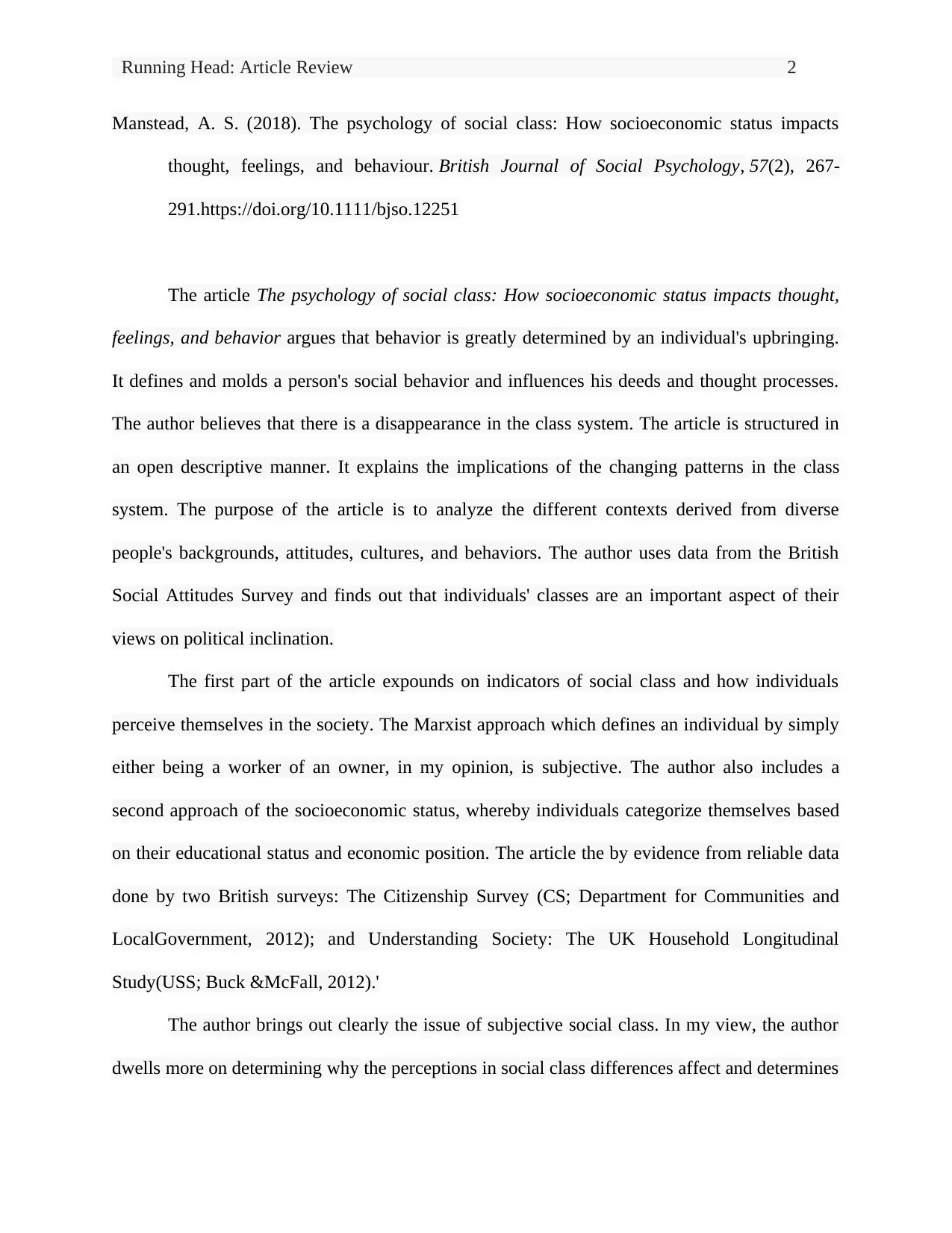
Running Head: Article Review 2
Manstead, A. S. (2018). The psychology of social class: How socioeconomic status impacts
thought, feelings, and behaviour. British Journal of Social Psychology, 57(2), 267-
291.https://doi.org/10.1111/bjso.12251
The article The psychology of social class: How socioeconomic status impacts thought,
feelings, and behavior argues that behavior is greatly determined by an individual's upbringing.
It defines and molds a person's social behavior and influences his deeds and thought processes.
The author believes that there is a disappearance in the class system. The article is structured in
an open descriptive manner. It explains the implications of the changing patterns in the class
system. The purpose of the article is to analyze the different contexts derived from diverse
people's backgrounds, attitudes, cultures, and behaviors. The author uses data from the British
Social Attitudes Survey and finds out that individuals' classes are an important aspect of their
views on political inclination.
The first part of the article expounds on indicators of social class and how individuals
perceive themselves in the society. The Marxist approach which defines an individual by simply
either being a worker of an owner, in my opinion, is subjective. The author also includes a
second approach of the socioeconomic status, whereby individuals categorize themselves based
on their educational status and economic position. The article the by evidence from reliable data
done by two British surveys: The Citizenship Survey (CS; Department for Communities and
LocalGovernment, 2012); and Understanding Society: The UK Household Longitudinal
Study(USS; Buck &McFall, 2012).'
The author brings out clearly the issue of subjective social class. In my view, the author
dwells more on determining why the perceptions in social class differences affect and determines
Manstead, A. S. (2018). The psychology of social class: How socioeconomic status impacts
thought, feelings, and behaviour. British Journal of Social Psychology, 57(2), 267-
291.https://doi.org/10.1111/bjso.12251
The article The psychology of social class: How socioeconomic status impacts thought,
feelings, and behavior argues that behavior is greatly determined by an individual's upbringing.
It defines and molds a person's social behavior and influences his deeds and thought processes.
The author believes that there is a disappearance in the class system. The article is structured in
an open descriptive manner. It explains the implications of the changing patterns in the class
system. The purpose of the article is to analyze the different contexts derived from diverse
people's backgrounds, attitudes, cultures, and behaviors. The author uses data from the British
Social Attitudes Survey and finds out that individuals' classes are an important aspect of their
views on political inclination.
The first part of the article expounds on indicators of social class and how individuals
perceive themselves in the society. The Marxist approach which defines an individual by simply
either being a worker of an owner, in my opinion, is subjective. The author also includes a
second approach of the socioeconomic status, whereby individuals categorize themselves based
on their educational status and economic position. The article the by evidence from reliable data
done by two British surveys: The Citizenship Survey (CS; Department for Communities and
LocalGovernment, 2012); and Understanding Society: The UK Household Longitudinal
Study(USS; Buck &McFall, 2012).'
The author brings out clearly the issue of subjective social class. In my view, the author
dwells more on determining why the perceptions in social class differences affect and determines
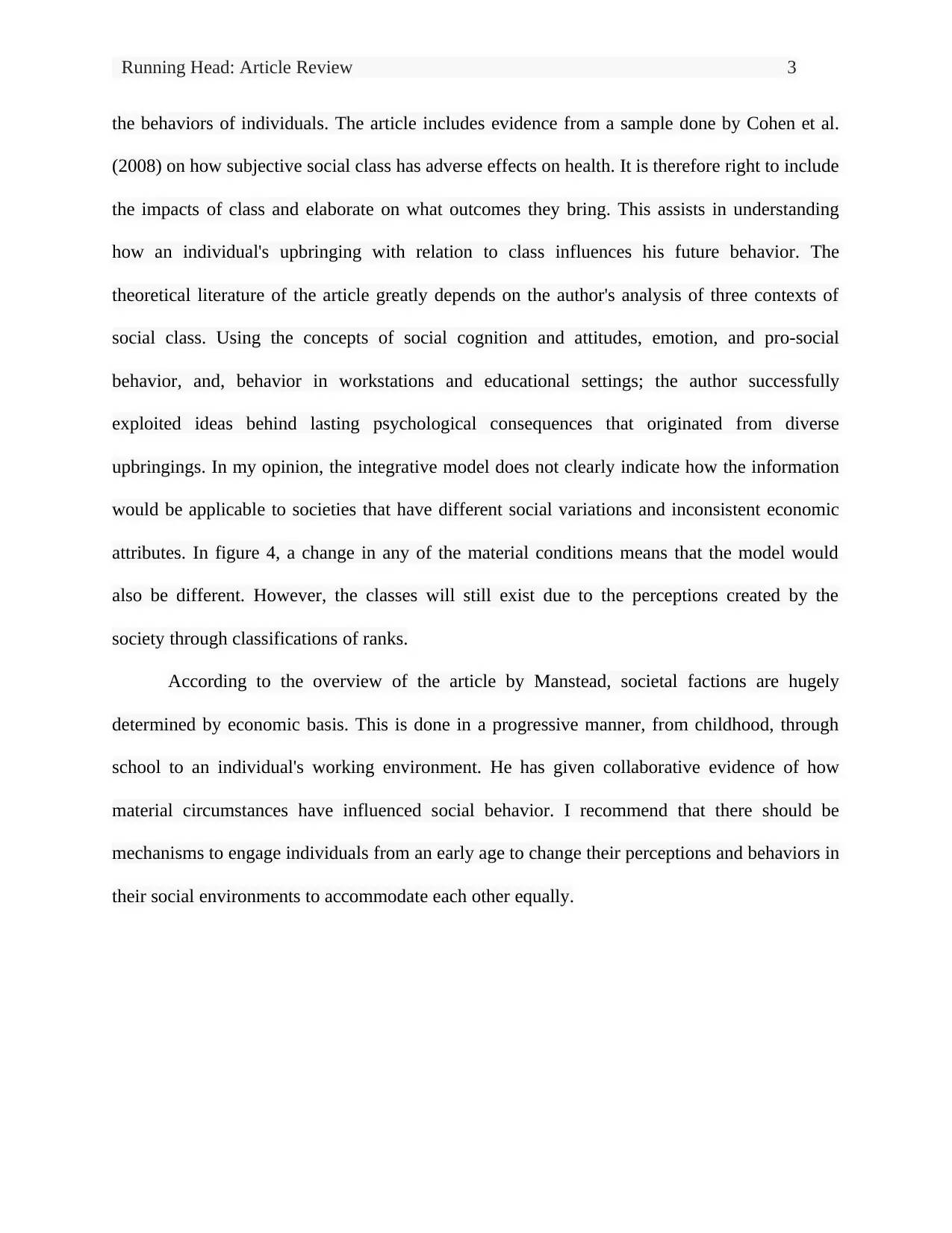
Running Head: Article Review 3
the behaviors of individuals. The article includes evidence from a sample done by Cohen et al.
(2008) on how subjective social class has adverse effects on health. It is therefore right to include
the impacts of class and elaborate on what outcomes they bring. This assists in understanding
how an individual's upbringing with relation to class influences his future behavior. The
theoretical literature of the article greatly depends on the author's analysis of three contexts of
social class. Using the concepts of social cognition and attitudes, emotion, and pro-social
behavior, and, behavior in workstations and educational settings; the author successfully
exploited ideas behind lasting psychological consequences that originated from diverse
upbringings. In my opinion, the integrative model does not clearly indicate how the information
would be applicable to societies that have different social variations and inconsistent economic
attributes. In figure 4, a change in any of the material conditions means that the model would
also be different. However, the classes will still exist due to the perceptions created by the
society through classifications of ranks.
According to the overview of the article by Manstead, societal factions are hugely
determined by economic basis. This is done in a progressive manner, from childhood, through
school to an individual's working environment. He has given collaborative evidence of how
material circumstances have influenced social behavior. I recommend that there should be
mechanisms to engage individuals from an early age to change their perceptions and behaviors in
their social environments to accommodate each other equally.
the behaviors of individuals. The article includes evidence from a sample done by Cohen et al.
(2008) on how subjective social class has adverse effects on health. It is therefore right to include
the impacts of class and elaborate on what outcomes they bring. This assists in understanding
how an individual's upbringing with relation to class influences his future behavior. The
theoretical literature of the article greatly depends on the author's analysis of three contexts of
social class. Using the concepts of social cognition and attitudes, emotion, and pro-social
behavior, and, behavior in workstations and educational settings; the author successfully
exploited ideas behind lasting psychological consequences that originated from diverse
upbringings. In my opinion, the integrative model does not clearly indicate how the information
would be applicable to societies that have different social variations and inconsistent economic
attributes. In figure 4, a change in any of the material conditions means that the model would
also be different. However, the classes will still exist due to the perceptions created by the
society through classifications of ranks.
According to the overview of the article by Manstead, societal factions are hugely
determined by economic basis. This is done in a progressive manner, from childhood, through
school to an individual's working environment. He has given collaborative evidence of how
material circumstances have influenced social behavior. I recommend that there should be
mechanisms to engage individuals from an early age to change their perceptions and behaviors in
their social environments to accommodate each other equally.
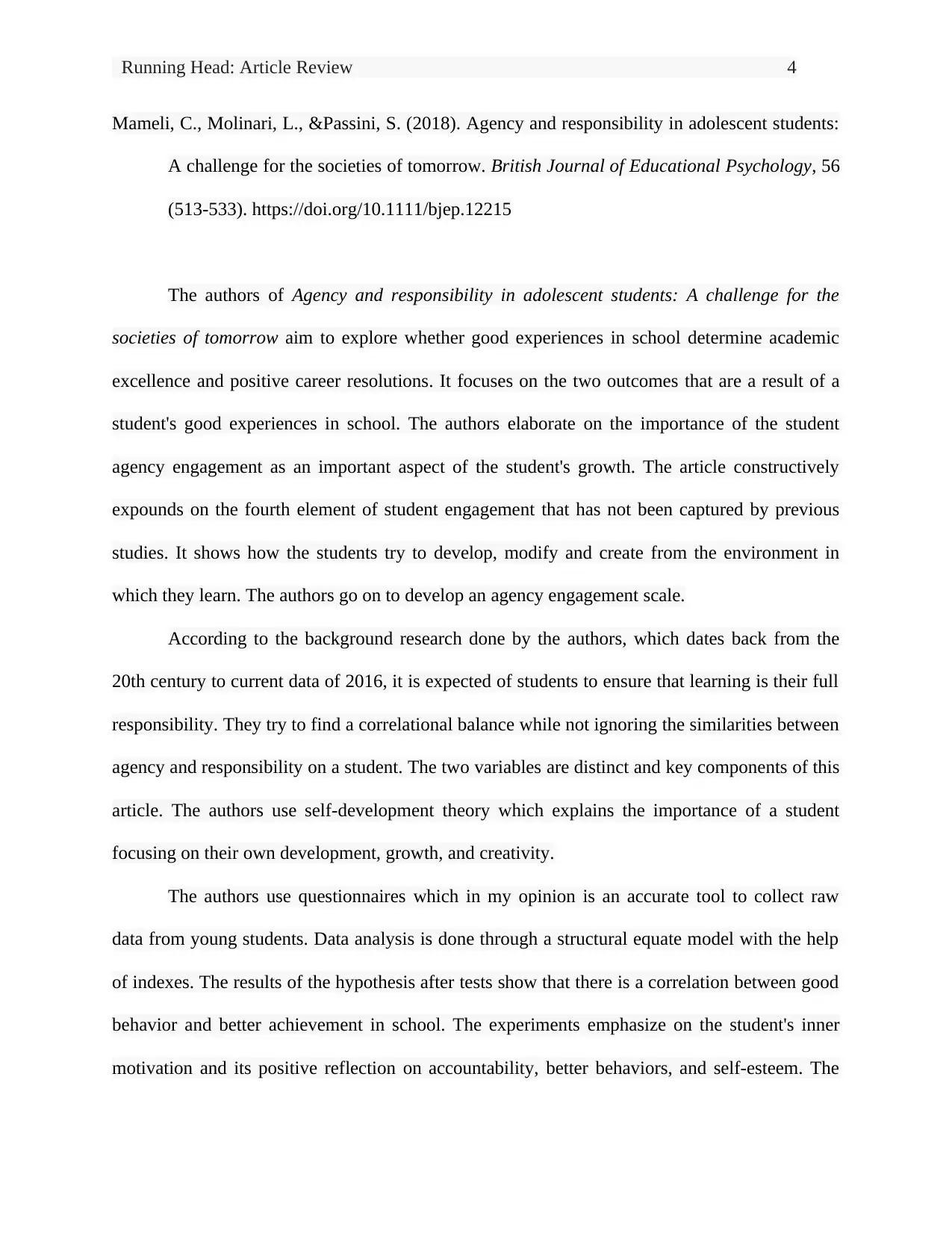
Running Head: Article Review 4
Mameli, C., Molinari, L., &Passini, S. (2018). Agency and responsibility in adolescent students:
A challenge for the societies of tomorrow. British Journal of Educational Psychology, 56
(513-533). https://doi.org/10.1111/bjep.12215
The authors of Agency and responsibility in adolescent students: A challenge for the
societies of tomorrow aim to explore whether good experiences in school determine academic
excellence and positive career resolutions. It focuses on the two outcomes that are a result of a
student's good experiences in school. The authors elaborate on the importance of the student
agency engagement as an important aspect of the student's growth. The article constructively
expounds on the fourth element of student engagement that has not been captured by previous
studies. It shows how the students try to develop, modify and create from the environment in
which they learn. The authors go on to develop an agency engagement scale.
According to the background research done by the authors, which dates back from the
20th century to current data of 2016, it is expected of students to ensure that learning is their full
responsibility. They try to find a correlational balance while not ignoring the similarities between
agency and responsibility on a student. The two variables are distinct and key components of this
article. The authors use self-development theory which explains the importance of a student
focusing on their own development, growth, and creativity.
The authors use questionnaires which in my opinion is an accurate tool to collect raw
data from young students. Data analysis is done through a structural equate model with the help
of indexes. The results of the hypothesis after tests show that there is a correlation between good
behavior and better achievement in school. The experiments emphasize on the student's inner
motivation and its positive reflection on accountability, better behaviors, and self-esteem. The
Mameli, C., Molinari, L., &Passini, S. (2018). Agency and responsibility in adolescent students:
A challenge for the societies of tomorrow. British Journal of Educational Psychology, 56
(513-533). https://doi.org/10.1111/bjep.12215
The authors of Agency and responsibility in adolescent students: A challenge for the
societies of tomorrow aim to explore whether good experiences in school determine academic
excellence and positive career resolutions. It focuses on the two outcomes that are a result of a
student's good experiences in school. The authors elaborate on the importance of the student
agency engagement as an important aspect of the student's growth. The article constructively
expounds on the fourth element of student engagement that has not been captured by previous
studies. It shows how the students try to develop, modify and create from the environment in
which they learn. The authors go on to develop an agency engagement scale.
According to the background research done by the authors, which dates back from the
20th century to current data of 2016, it is expected of students to ensure that learning is their full
responsibility. They try to find a correlational balance while not ignoring the similarities between
agency and responsibility on a student. The two variables are distinct and key components of this
article. The authors use self-development theory which explains the importance of a student
focusing on their own development, growth, and creativity.
The authors use questionnaires which in my opinion is an accurate tool to collect raw
data from young students. Data analysis is done through a structural equate model with the help
of indexes. The results of the hypothesis after tests show that there is a correlation between good
behavior and better achievement in school. The experiments emphasize on the student's inner
motivation and its positive reflection on accountability, better behaviors, and self-esteem. The
Secure Best Marks with AI Grader
Need help grading? Try our AI Grader for instant feedback on your assignments.
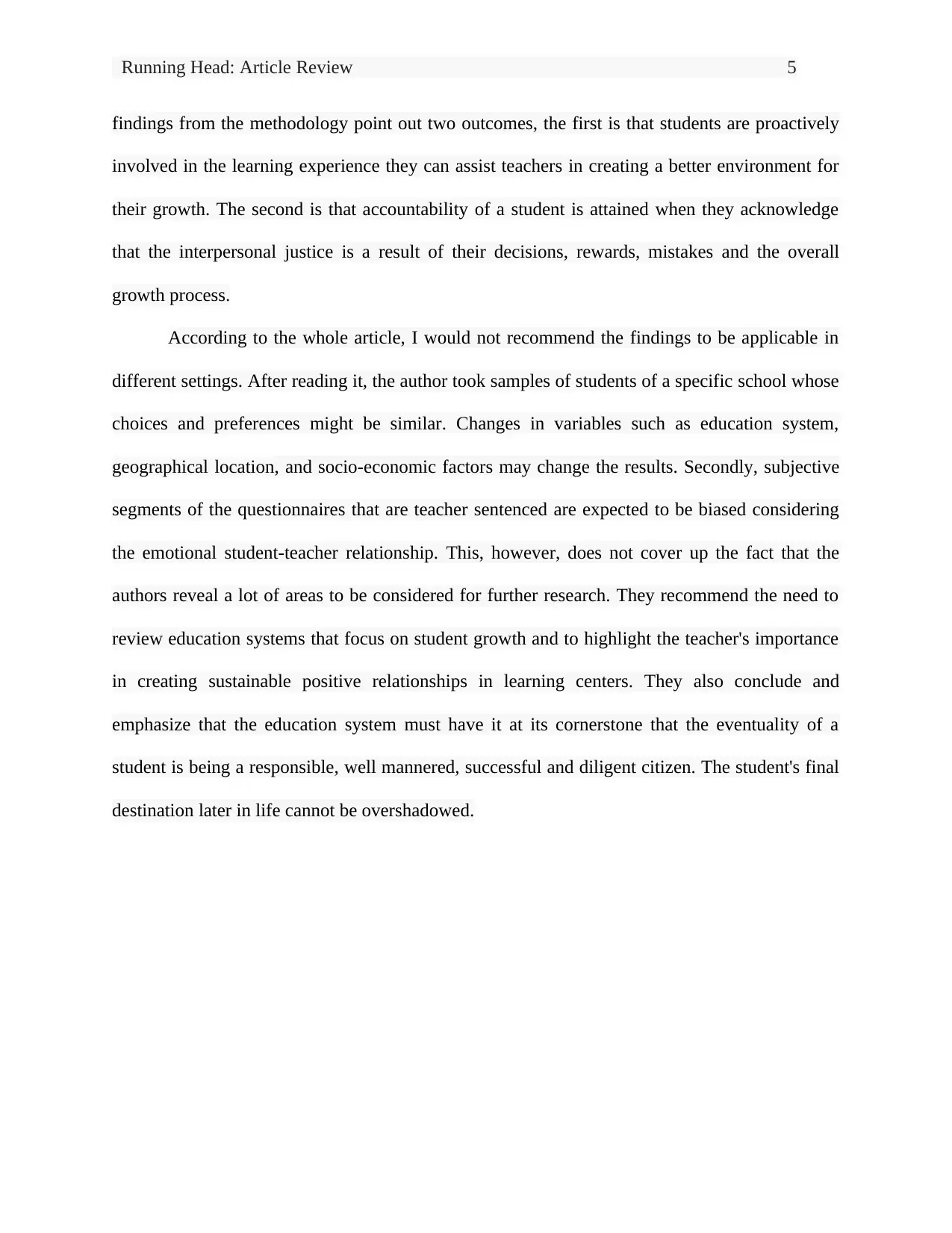
Running Head: Article Review 5
findings from the methodology point out two outcomes, the first is that students are proactively
involved in the learning experience they can assist teachers in creating a better environment for
their growth. The second is that accountability of a student is attained when they acknowledge
that the interpersonal justice is a result of their decisions, rewards, mistakes and the overall
growth process.
According to the whole article, I would not recommend the findings to be applicable in
different settings. After reading it, the author took samples of students of a specific school whose
choices and preferences might be similar. Changes in variables such as education system,
geographical location, and socio-economic factors may change the results. Secondly, subjective
segments of the questionnaires that are teacher sentenced are expected to be biased considering
the emotional student-teacher relationship. This, however, does not cover up the fact that the
authors reveal a lot of areas to be considered for further research. They recommend the need to
review education systems that focus on student growth and to highlight the teacher's importance
in creating sustainable positive relationships in learning centers. They also conclude and
emphasize that the education system must have it at its cornerstone that the eventuality of a
student is being a responsible, well mannered, successful and diligent citizen. The student's final
destination later in life cannot be overshadowed.
findings from the methodology point out two outcomes, the first is that students are proactively
involved in the learning experience they can assist teachers in creating a better environment for
their growth. The second is that accountability of a student is attained when they acknowledge
that the interpersonal justice is a result of their decisions, rewards, mistakes and the overall
growth process.
According to the whole article, I would not recommend the findings to be applicable in
different settings. After reading it, the author took samples of students of a specific school whose
choices and preferences might be similar. Changes in variables such as education system,
geographical location, and socio-economic factors may change the results. Secondly, subjective
segments of the questionnaires that are teacher sentenced are expected to be biased considering
the emotional student-teacher relationship. This, however, does not cover up the fact that the
authors reveal a lot of areas to be considered for further research. They recommend the need to
review education systems that focus on student growth and to highlight the teacher's importance
in creating sustainable positive relationships in learning centers. They also conclude and
emphasize that the education system must have it at its cornerstone that the eventuality of a
student is being a responsible, well mannered, successful and diligent citizen. The student's final
destination later in life cannot be overshadowed.
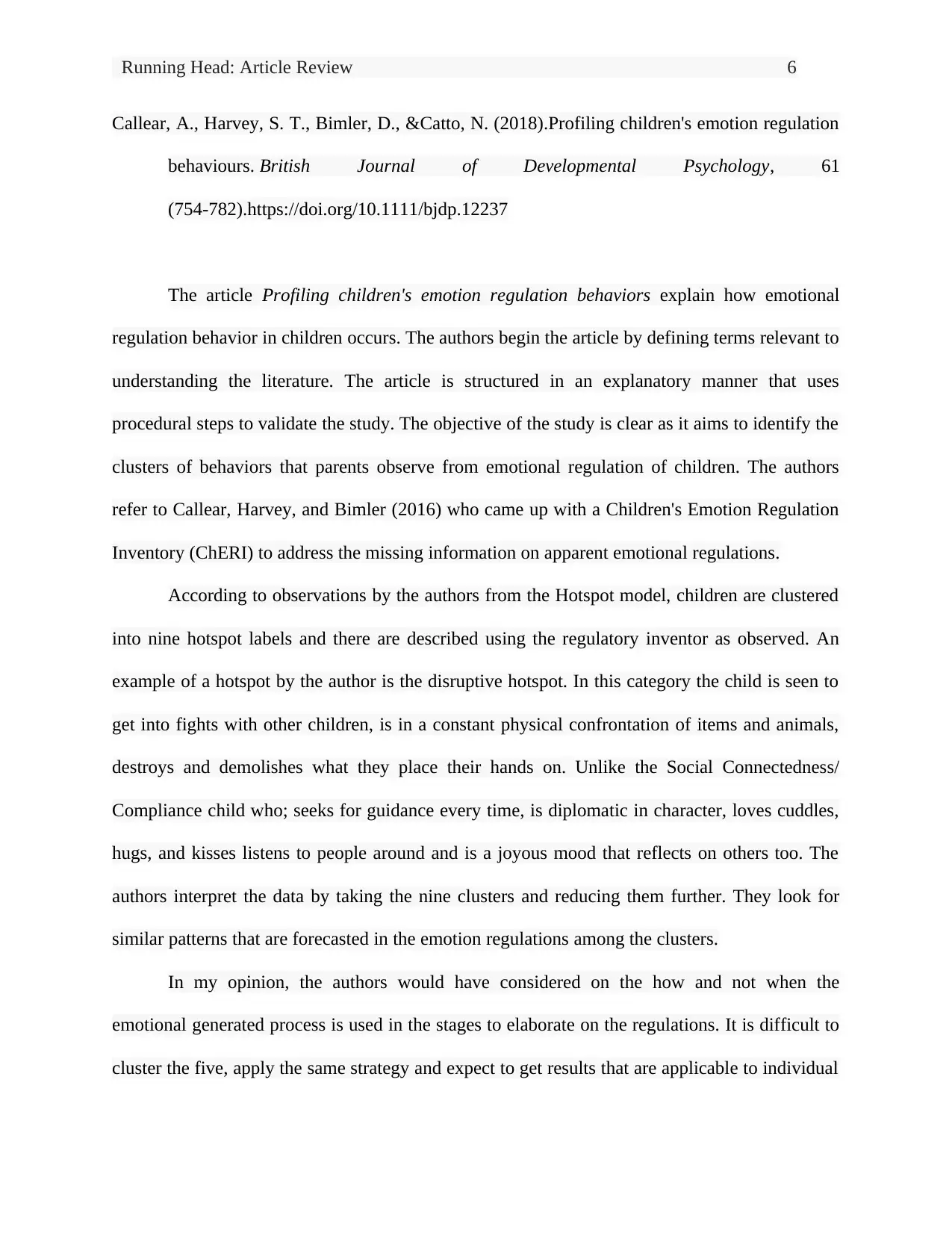
Running Head: Article Review 6
Callear, A., Harvey, S. T., Bimler, D., &Catto, N. (2018).Profiling children's emotion regulation
behaviours. British Journal of Developmental Psychology, 61
(754-782).https://doi.org/10.1111/bjdp.12237
The article Profiling children's emotion regulation behaviors explain how emotional
regulation behavior in children occurs. The authors begin the article by defining terms relevant to
understanding the literature. The article is structured in an explanatory manner that uses
procedural steps to validate the study. The objective of the study is clear as it aims to identify the
clusters of behaviors that parents observe from emotional regulation of children. The authors
refer to Callear, Harvey, and Bimler (2016) who came up with a Children's Emotion Regulation
Inventory (ChERI) to address the missing information on apparent emotional regulations.
According to observations by the authors from the Hotspot model, children are clustered
into nine hotspot labels and there are described using the regulatory inventor as observed. An
example of a hotspot by the author is the disruptive hotspot. In this category the child is seen to
get into fights with other children, is in a constant physical confrontation of items and animals,
destroys and demolishes what they place their hands on. Unlike the Social Connectedness/
Compliance child who; seeks for guidance every time, is diplomatic in character, loves cuddles,
hugs, and kisses listens to people around and is a joyous mood that reflects on others too. The
authors interpret the data by taking the nine clusters and reducing them further. They look for
similar patterns that are forecasted in the emotion regulations among the clusters.
In my opinion, the authors would have considered on the how and not when the
emotional generated process is used in the stages to elaborate on the regulations. It is difficult to
cluster the five, apply the same strategy and expect to get results that are applicable to individual
Callear, A., Harvey, S. T., Bimler, D., &Catto, N. (2018).Profiling children's emotion regulation
behaviours. British Journal of Developmental Psychology, 61
(754-782).https://doi.org/10.1111/bjdp.12237
The article Profiling children's emotion regulation behaviors explain how emotional
regulation behavior in children occurs. The authors begin the article by defining terms relevant to
understanding the literature. The article is structured in an explanatory manner that uses
procedural steps to validate the study. The objective of the study is clear as it aims to identify the
clusters of behaviors that parents observe from emotional regulation of children. The authors
refer to Callear, Harvey, and Bimler (2016) who came up with a Children's Emotion Regulation
Inventory (ChERI) to address the missing information on apparent emotional regulations.
According to observations by the authors from the Hotspot model, children are clustered
into nine hotspot labels and there are described using the regulatory inventor as observed. An
example of a hotspot by the author is the disruptive hotspot. In this category the child is seen to
get into fights with other children, is in a constant physical confrontation of items and animals,
destroys and demolishes what they place their hands on. Unlike the Social Connectedness/
Compliance child who; seeks for guidance every time, is diplomatic in character, loves cuddles,
hugs, and kisses listens to people around and is a joyous mood that reflects on others too. The
authors interpret the data by taking the nine clusters and reducing them further. They look for
similar patterns that are forecasted in the emotion regulations among the clusters.
In my opinion, the authors would have considered on the how and not when the
emotional generated process is used in the stages to elaborate on the regulations. It is difficult to
cluster the five, apply the same strategy and expect to get results that are applicable to individual
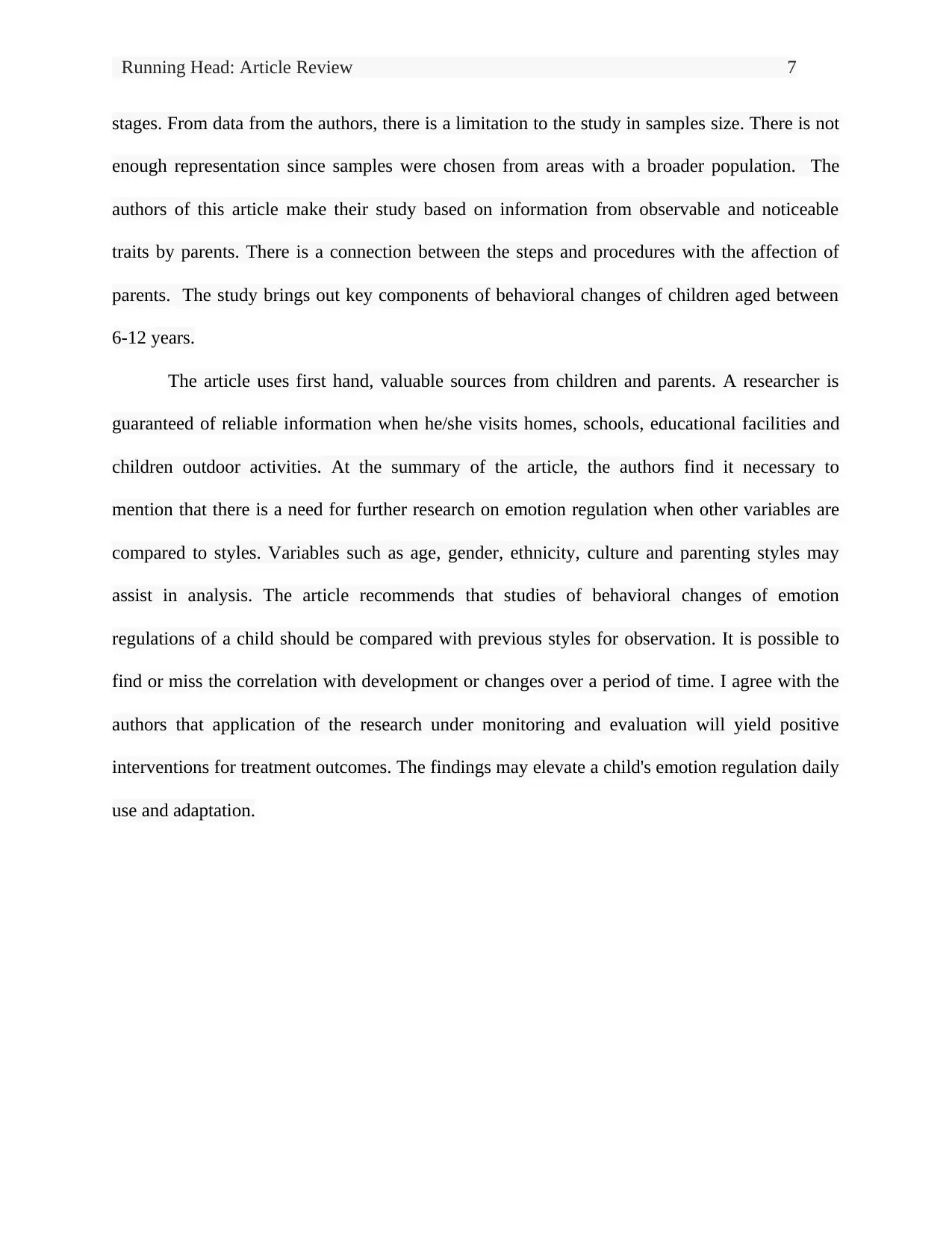
Running Head: Article Review 7
stages. From data from the authors, there is a limitation to the study in samples size. There is not
enough representation since samples were chosen from areas with a broader population. The
authors of this article make their study based on information from observable and noticeable
traits by parents. There is a connection between the steps and procedures with the affection of
parents. The study brings out key components of behavioral changes of children aged between
6-12 years.
The article uses first hand, valuable sources from children and parents. A researcher is
guaranteed of reliable information when he/she visits homes, schools, educational facilities and
children outdoor activities. At the summary of the article, the authors find it necessary to
mention that there is a need for further research on emotion regulation when other variables are
compared to styles. Variables such as age, gender, ethnicity, culture and parenting styles may
assist in analysis. The article recommends that studies of behavioral changes of emotion
regulations of a child should be compared with previous styles for observation. It is possible to
find or miss the correlation with development or changes over a period of time. I agree with the
authors that application of the research under monitoring and evaluation will yield positive
interventions for treatment outcomes. The findings may elevate a child's emotion regulation daily
use and adaptation.
stages. From data from the authors, there is a limitation to the study in samples size. There is not
enough representation since samples were chosen from areas with a broader population. The
authors of this article make their study based on information from observable and noticeable
traits by parents. There is a connection between the steps and procedures with the affection of
parents. The study brings out key components of behavioral changes of children aged between
6-12 years.
The article uses first hand, valuable sources from children and parents. A researcher is
guaranteed of reliable information when he/she visits homes, schools, educational facilities and
children outdoor activities. At the summary of the article, the authors find it necessary to
mention that there is a need for further research on emotion regulation when other variables are
compared to styles. Variables such as age, gender, ethnicity, culture and parenting styles may
assist in analysis. The article recommends that studies of behavioral changes of emotion
regulations of a child should be compared with previous styles for observation. It is possible to
find or miss the correlation with development or changes over a period of time. I agree with the
authors that application of the research under monitoring and evaluation will yield positive
interventions for treatment outcomes. The findings may elevate a child's emotion regulation daily
use and adaptation.
Paraphrase This Document
Need a fresh take? Get an instant paraphrase of this document with our AI Paraphraser

Running Head: Article Review 8
Heiphetz, L., Lane, J. D., Waytz, A., & Young, L. L. (2018). My mind, your mind, and God's
mind: How children and adults conceive of different agents’ moral beliefs. British
Journal of Developmental Psychology, 52(3) 413-432.https://doi.org/10.1111/bjdp.12231
The article My mind, your mind, and God's mind: How children and adults conceive of
different agents' moral belief aims to discuss theories concerning beliefs. The research focuses
on 508-year-olds to make a distinction between their own beliefs and other people's beliefs from
those of God. The introduction and arrangement of the article are descriptive while engaging the
use of experiments. Two aspects come out clearly in the objectives of the research. The first is
the investigation of moral beliefs attributes to those of different agents and the second is testing
both adults and children to establish the importance of age and how they affect belief attributes.
Previous literature is used as the background of the study to build knowledge and views of
people about God. The authors use moral questions to base their arguments, where they find out
those questions regarding trustworthy behavior the unlike those regarding blameworthy
behavior. It continues to establish that adults and children both based their morals on those of
God. They continue to acknowledge that God is omniscience and all-knowing, and His morals
are considerably high. They, however, state that not all gods care about morality.
According to the authors, theories about God's mind that have not been researched on
previous works are crucial in establishing moral behaviors. They test using three perspectives on
the judgment of both children and adult about the mind of God. The first theory is that they are
similar to God and each other but different from other people. The second theory is that they are
different from God and other people. The third theory is the belief that there is no mind like
God's; He is different from any other person's. The research focuses on children from 5-8 years
Heiphetz, L., Lane, J. D., Waytz, A., & Young, L. L. (2018). My mind, your mind, and God's
mind: How children and adults conceive of different agents’ moral beliefs. British
Journal of Developmental Psychology, 52(3) 413-432.https://doi.org/10.1111/bjdp.12231
The article My mind, your mind, and God's mind: How children and adults conceive of
different agents' moral belief aims to discuss theories concerning beliefs. The research focuses
on 508-year-olds to make a distinction between their own beliefs and other people's beliefs from
those of God. The introduction and arrangement of the article are descriptive while engaging the
use of experiments. Two aspects come out clearly in the objectives of the research. The first is
the investigation of moral beliefs attributes to those of different agents and the second is testing
both adults and children to establish the importance of age and how they affect belief attributes.
Previous literature is used as the background of the study to build knowledge and views of
people about God. The authors use moral questions to base their arguments, where they find out
those questions regarding trustworthy behavior the unlike those regarding blameworthy
behavior. It continues to establish that adults and children both based their morals on those of
God. They continue to acknowledge that God is omniscience and all-knowing, and His morals
are considerably high. They, however, state that not all gods care about morality.
According to the authors, theories about God's mind that have not been researched on
previous works are crucial in establishing moral behaviors. They test using three perspectives on
the judgment of both children and adult about the mind of God. The first theory is that they are
similar to God and each other but different from other people. The second theory is that they are
different from God and other people. The third theory is the belief that there is no mind like
God's; He is different from any other person's. The research focuses on children from 5-8 years
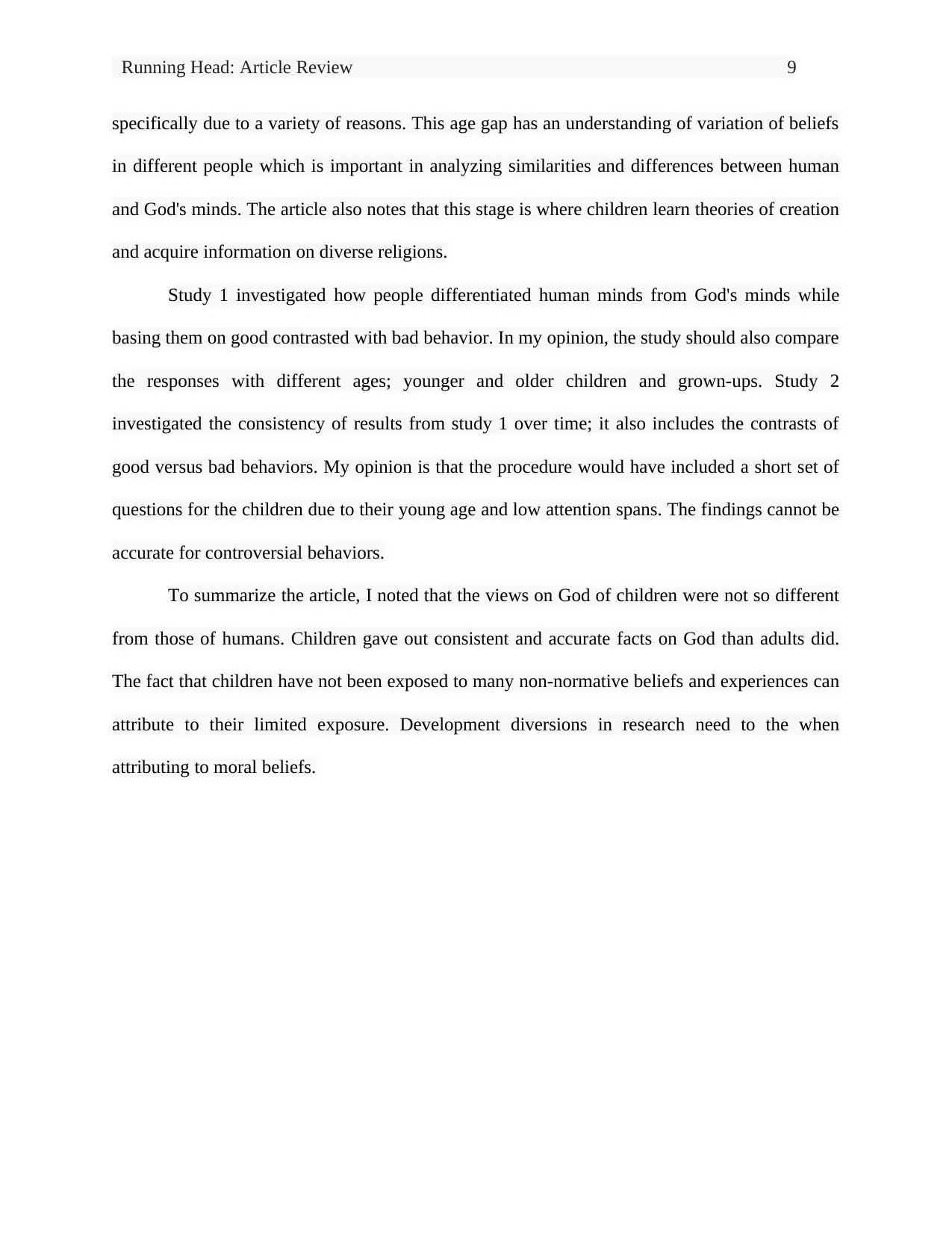
Running Head: Article Review 9
specifically due to a variety of reasons. This age gap has an understanding of variation of beliefs
in different people which is important in analyzing similarities and differences between human
and God's minds. The article also notes that this stage is where children learn theories of creation
and acquire information on diverse religions.
Study 1 investigated how people differentiated human minds from God's minds while
basing them on good contrasted with bad behavior. In my opinion, the study should also compare
the responses with different ages; younger and older children and grown-ups. Study 2
investigated the consistency of results from study 1 over time; it also includes the contrasts of
good versus bad behaviors. My opinion is that the procedure would have included a short set of
questions for the children due to their young age and low attention spans. The findings cannot be
accurate for controversial behaviors.
To summarize the article, I noted that the views on God of children were not so different
from those of humans. Children gave out consistent and accurate facts on God than adults did.
The fact that children have not been exposed to many non-normative beliefs and experiences can
attribute to their limited exposure. Development diversions in research need to the when
attributing to moral beliefs.
specifically due to a variety of reasons. This age gap has an understanding of variation of beliefs
in different people which is important in analyzing similarities and differences between human
and God's minds. The article also notes that this stage is where children learn theories of creation
and acquire information on diverse religions.
Study 1 investigated how people differentiated human minds from God's minds while
basing them on good contrasted with bad behavior. In my opinion, the study should also compare
the responses with different ages; younger and older children and grown-ups. Study 2
investigated the consistency of results from study 1 over time; it also includes the contrasts of
good versus bad behaviors. My opinion is that the procedure would have included a short set of
questions for the children due to their young age and low attention spans. The findings cannot be
accurate for controversial behaviors.
To summarize the article, I noted that the views on God of children were not so different
from those of humans. Children gave out consistent and accurate facts on God than adults did.
The fact that children have not been exposed to many non-normative beliefs and experiences can
attribute to their limited exposure. Development diversions in research need to the when
attributing to moral beliefs.
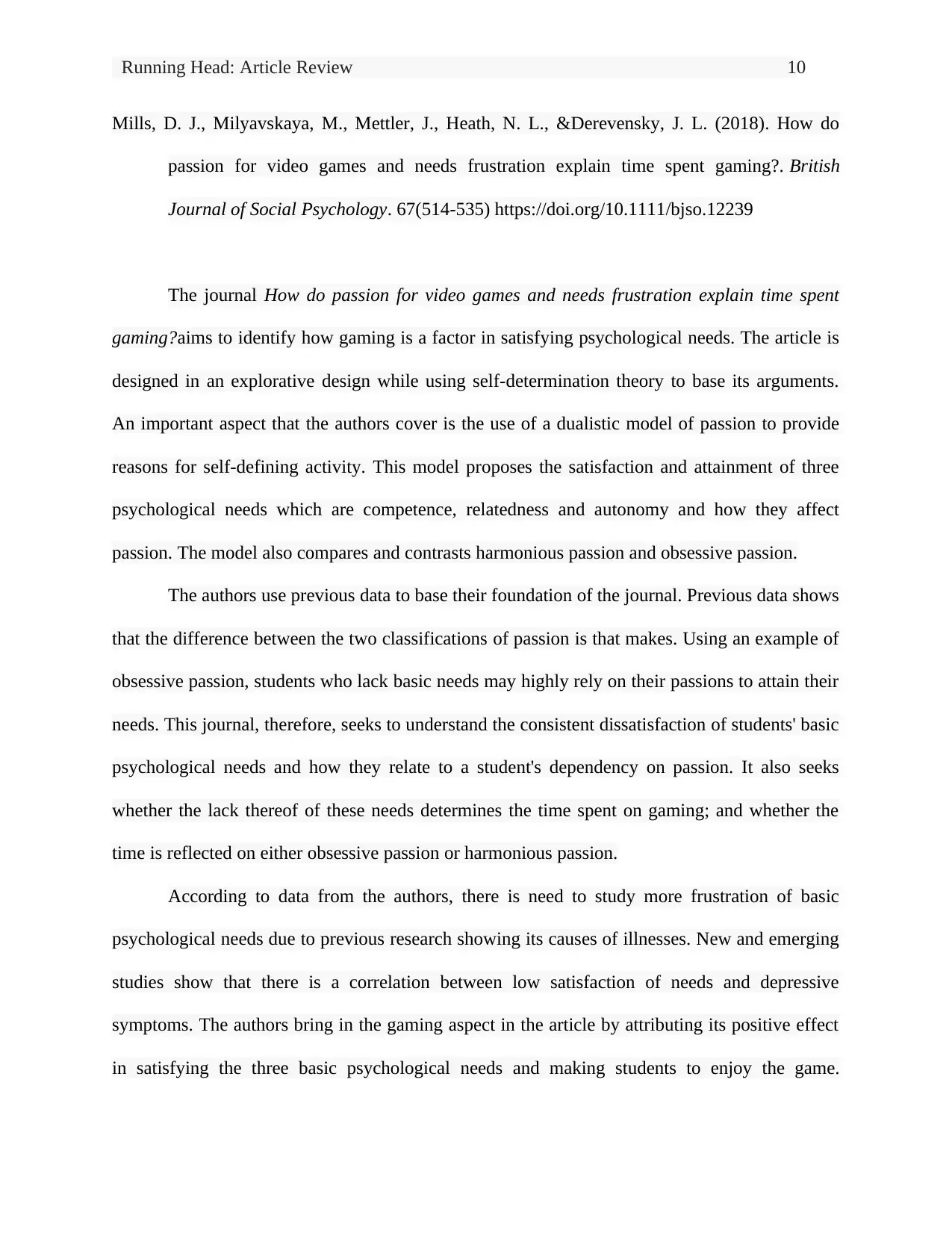
Running Head: Article Review 10
Mills, D. J., Milyavskaya, M., Mettler, J., Heath, N. L., &Derevensky, J. L. (2018). How do
passion for video games and needs frustration explain time spent gaming?. British
Journal of Social Psychology. 67(514-535) https://doi.org/10.1111/bjso.12239
The journal How do passion for video games and needs frustration explain time spent
gaming?aims to identify how gaming is a factor in satisfying psychological needs. The article is
designed in an explorative design while using self-determination theory to base its arguments.
An important aspect that the authors cover is the use of a dualistic model of passion to provide
reasons for self-defining activity. This model proposes the satisfaction and attainment of three
psychological needs which are competence, relatedness and autonomy and how they affect
passion. The model also compares and contrasts harmonious passion and obsessive passion.
The authors use previous data to base their foundation of the journal. Previous data shows
that the difference between the two classifications of passion is that makes. Using an example of
obsessive passion, students who lack basic needs may highly rely on their passions to attain their
needs. This journal, therefore, seeks to understand the consistent dissatisfaction of students' basic
psychological needs and how they relate to a student's dependency on passion. It also seeks
whether the lack thereof of these needs determines the time spent on gaming; and whether the
time is reflected on either obsessive passion or harmonious passion.
According to data from the authors, there is need to study more frustration of basic
psychological needs due to previous research showing its causes of illnesses. New and emerging
studies show that there is a correlation between low satisfaction of needs and depressive
symptoms. The authors bring in the gaming aspect in the article by attributing its positive effect
in satisfying the three basic psychological needs and making students to enjoy the game.
Mills, D. J., Milyavskaya, M., Mettler, J., Heath, N. L., &Derevensky, J. L. (2018). How do
passion for video games and needs frustration explain time spent gaming?. British
Journal of Social Psychology. 67(514-535) https://doi.org/10.1111/bjso.12239
The journal How do passion for video games and needs frustration explain time spent
gaming?aims to identify how gaming is a factor in satisfying psychological needs. The article is
designed in an explorative design while using self-determination theory to base its arguments.
An important aspect that the authors cover is the use of a dualistic model of passion to provide
reasons for self-defining activity. This model proposes the satisfaction and attainment of three
psychological needs which are competence, relatedness and autonomy and how they affect
passion. The model also compares and contrasts harmonious passion and obsessive passion.
The authors use previous data to base their foundation of the journal. Previous data shows
that the difference between the two classifications of passion is that makes. Using an example of
obsessive passion, students who lack basic needs may highly rely on their passions to attain their
needs. This journal, therefore, seeks to understand the consistent dissatisfaction of students' basic
psychological needs and how they relate to a student's dependency on passion. It also seeks
whether the lack thereof of these needs determines the time spent on gaming; and whether the
time is reflected on either obsessive passion or harmonious passion.
According to data from the authors, there is need to study more frustration of basic
psychological needs due to previous research showing its causes of illnesses. New and emerging
studies show that there is a correlation between low satisfaction of needs and depressive
symptoms. The authors bring in the gaming aspect in the article by attributing its positive effect
in satisfying the three basic psychological needs and making students to enjoy the game.
Secure Best Marks with AI Grader
Need help grading? Try our AI Grader for instant feedback on your assignments.
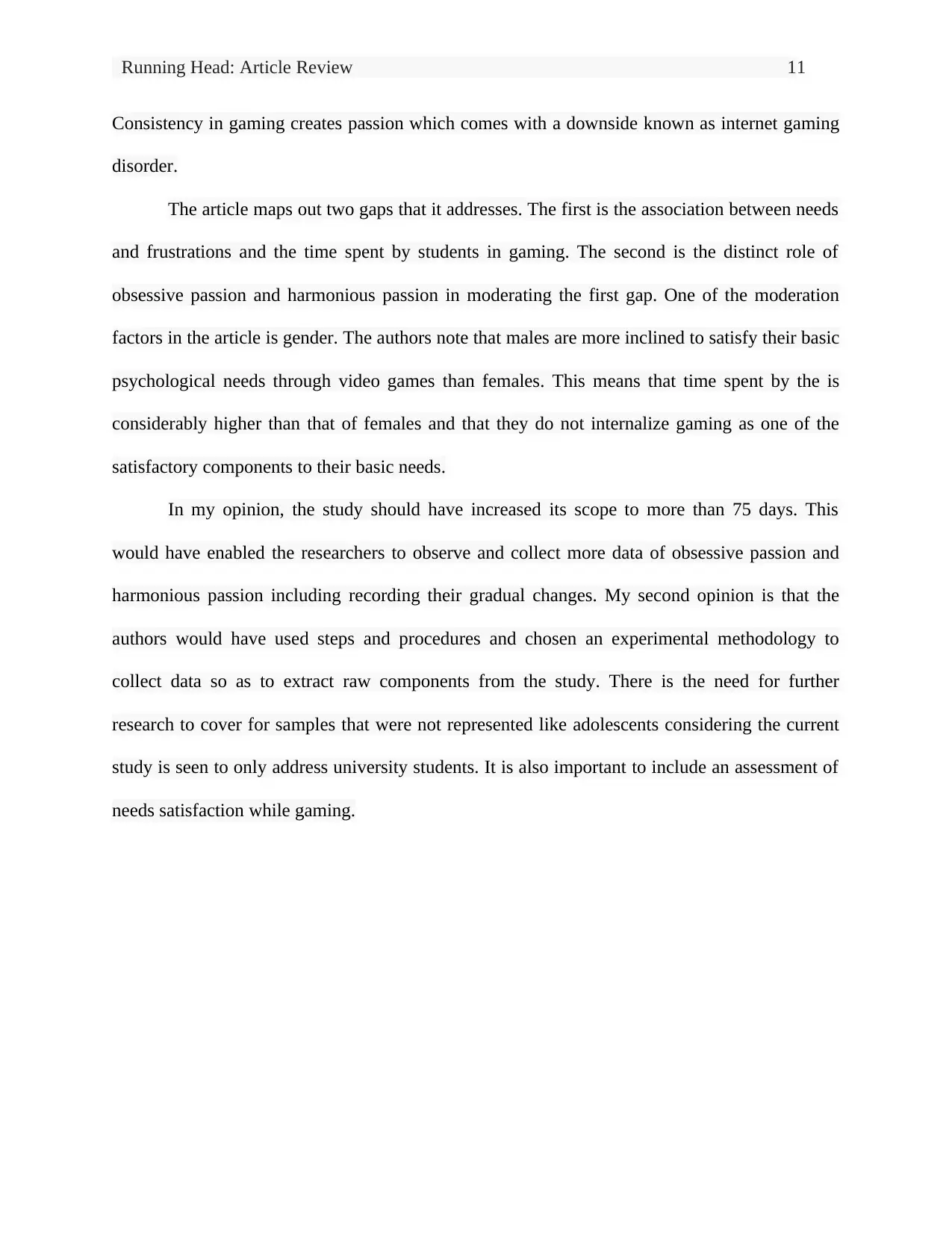
Running Head: Article Review 11
Consistency in gaming creates passion which comes with a downside known as internet gaming
disorder.
The article maps out two gaps that it addresses. The first is the association between needs
and frustrations and the time spent by students in gaming. The second is the distinct role of
obsessive passion and harmonious passion in moderating the first gap. One of the moderation
factors in the article is gender. The authors note that males are more inclined to satisfy their basic
psychological needs through video games than females. This means that time spent by the is
considerably higher than that of females and that they do not internalize gaming as one of the
satisfactory components to their basic needs.
In my opinion, the study should have increased its scope to more than 75 days. This
would have enabled the researchers to observe and collect more data of obsessive passion and
harmonious passion including recording their gradual changes. My second opinion is that the
authors would have used steps and procedures and chosen an experimental methodology to
collect data so as to extract raw components from the study. There is the need for further
research to cover for samples that were not represented like adolescents considering the current
study is seen to only address university students. It is also important to include an assessment of
needs satisfaction while gaming.
Consistency in gaming creates passion which comes with a downside known as internet gaming
disorder.
The article maps out two gaps that it addresses. The first is the association between needs
and frustrations and the time spent by students in gaming. The second is the distinct role of
obsessive passion and harmonious passion in moderating the first gap. One of the moderation
factors in the article is gender. The authors note that males are more inclined to satisfy their basic
psychological needs through video games than females. This means that time spent by the is
considerably higher than that of females and that they do not internalize gaming as one of the
satisfactory components to their basic needs.
In my opinion, the study should have increased its scope to more than 75 days. This
would have enabled the researchers to observe and collect more data of obsessive passion and
harmonious passion including recording their gradual changes. My second opinion is that the
authors would have used steps and procedures and chosen an experimental methodology to
collect data so as to extract raw components from the study. There is the need for further
research to cover for samples that were not represented like adolescents considering the current
study is seen to only address university students. It is also important to include an assessment of
needs satisfaction while gaming.
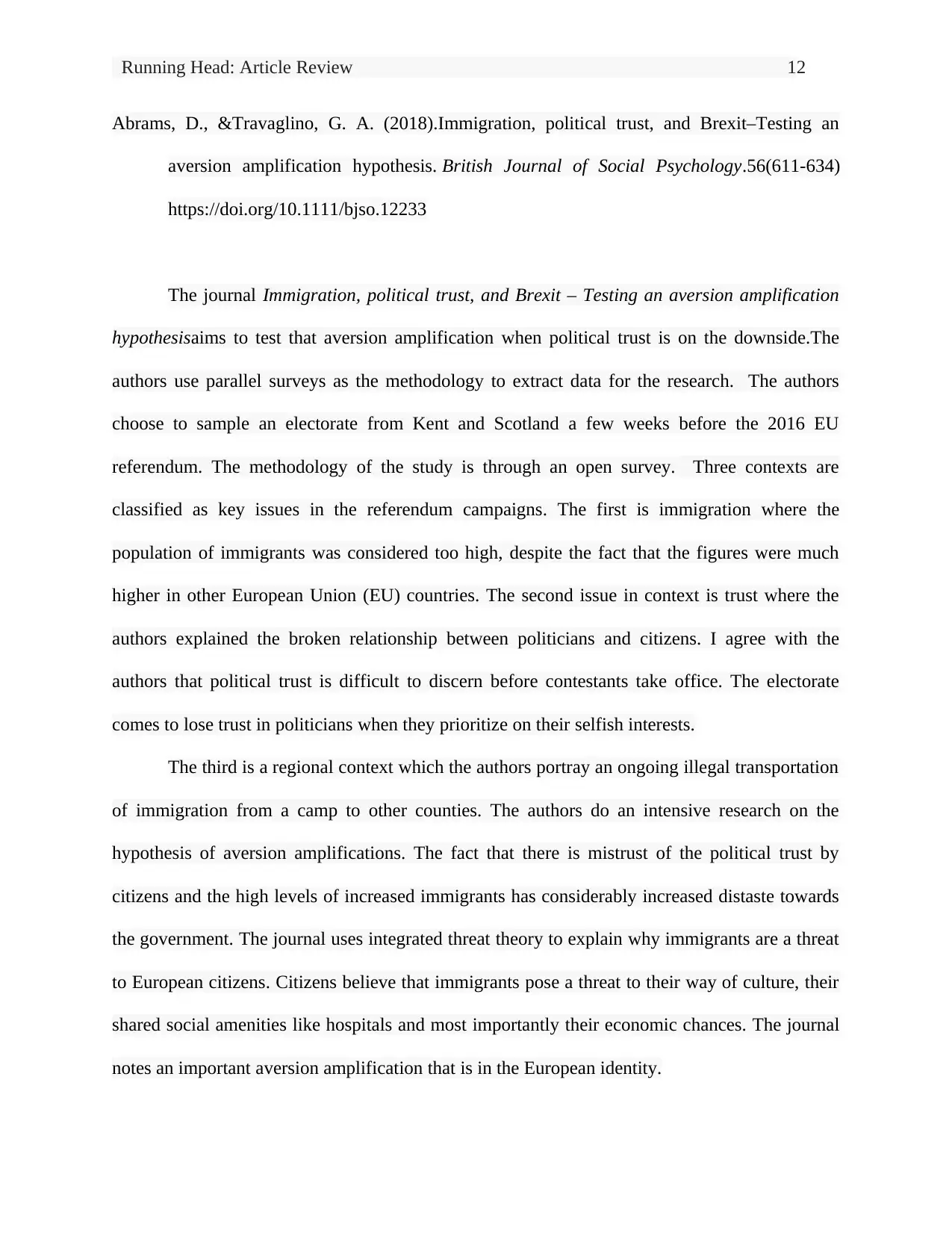
Running Head: Article Review 12
Abrams, D., &Travaglino, G. A. (2018).Immigration, political trust, and Brexit–Testing an
aversion amplification hypothesis. British Journal of Social Psychology.56(611-634)
https://doi.org/10.1111/bjso.12233
The journal Immigration, political trust, and Brexit – Testing an aversion amplification
hypothesisaims to test that aversion amplification when political trust is on the downside.The
authors use parallel surveys as the methodology to extract data for the research. The authors
choose to sample an electorate from Kent and Scotland a few weeks before the 2016 EU
referendum. The methodology of the study is through an open survey. Three contexts are
classified as key issues in the referendum campaigns. The first is immigration where the
population of immigrants was considered too high, despite the fact that the figures were much
higher in other European Union (EU) countries. The second issue in context is trust where the
authors explained the broken relationship between politicians and citizens. I agree with the
authors that political trust is difficult to discern before contestants take office. The electorate
comes to lose trust in politicians when they prioritize on their selfish interests.
The third is a regional context which the authors portray an ongoing illegal transportation
of immigration from a camp to other counties. The authors do an intensive research on the
hypothesis of aversion amplifications. The fact that there is mistrust of the political trust by
citizens and the high levels of increased immigrants has considerably increased distaste towards
the government. The journal uses integrated threat theory to explain why immigrants are a threat
to European citizens. Citizens believe that immigrants pose a threat to their way of culture, their
shared social amenities like hospitals and most importantly their economic chances. The journal
notes an important aversion amplification that is in the European identity.
Abrams, D., &Travaglino, G. A. (2018).Immigration, political trust, and Brexit–Testing an
aversion amplification hypothesis. British Journal of Social Psychology.56(611-634)
https://doi.org/10.1111/bjso.12233
The journal Immigration, political trust, and Brexit – Testing an aversion amplification
hypothesisaims to test that aversion amplification when political trust is on the downside.The
authors use parallel surveys as the methodology to extract data for the research. The authors
choose to sample an electorate from Kent and Scotland a few weeks before the 2016 EU
referendum. The methodology of the study is through an open survey. Three contexts are
classified as key issues in the referendum campaigns. The first is immigration where the
population of immigrants was considered too high, despite the fact that the figures were much
higher in other European Union (EU) countries. The second issue in context is trust where the
authors explained the broken relationship between politicians and citizens. I agree with the
authors that political trust is difficult to discern before contestants take office. The electorate
comes to lose trust in politicians when they prioritize on their selfish interests.
The third is a regional context which the authors portray an ongoing illegal transportation
of immigration from a camp to other counties. The authors do an intensive research on the
hypothesis of aversion amplifications. The fact that there is mistrust of the political trust by
citizens and the high levels of increased immigrants has considerably increased distaste towards
the government. The journal uses integrated threat theory to explain why immigrants are a threat
to European citizens. Citizens believe that immigrants pose a threat to their way of culture, their
shared social amenities like hospitals and most importantly their economic chances. The journal
notes an important aversion amplification that is in the European identity.
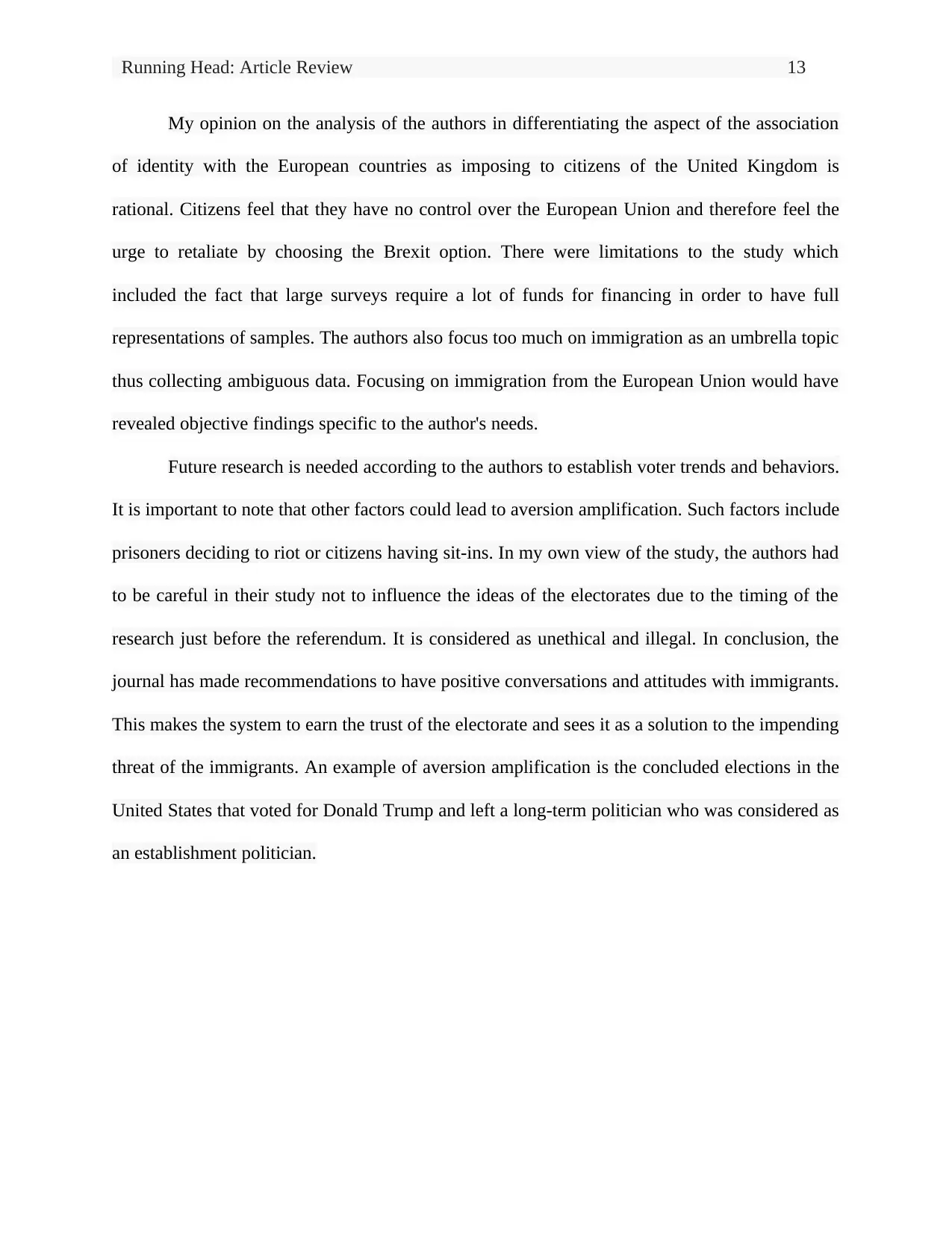
Running Head: Article Review 13
My opinion on the analysis of the authors in differentiating the aspect of the association
of identity with the European countries as imposing to citizens of the United Kingdom is
rational. Citizens feel that they have no control over the European Union and therefore feel the
urge to retaliate by choosing the Brexit option. There were limitations to the study which
included the fact that large surveys require a lot of funds for financing in order to have full
representations of samples. The authors also focus too much on immigration as an umbrella topic
thus collecting ambiguous data. Focusing on immigration from the European Union would have
revealed objective findings specific to the author's needs.
Future research is needed according to the authors to establish voter trends and behaviors.
It is important to note that other factors could lead to aversion amplification. Such factors include
prisoners deciding to riot or citizens having sit-ins. In my own view of the study, the authors had
to be careful in their study not to influence the ideas of the electorates due to the timing of the
research just before the referendum. It is considered as unethical and illegal. In conclusion, the
journal has made recommendations to have positive conversations and attitudes with immigrants.
This makes the system to earn the trust of the electorate and sees it as a solution to the impending
threat of the immigrants. An example of aversion amplification is the concluded elections in the
United States that voted for Donald Trump and left a long-term politician who was considered as
an establishment politician.
My opinion on the analysis of the authors in differentiating the aspect of the association
of identity with the European countries as imposing to citizens of the United Kingdom is
rational. Citizens feel that they have no control over the European Union and therefore feel the
urge to retaliate by choosing the Brexit option. There were limitations to the study which
included the fact that large surveys require a lot of funds for financing in order to have full
representations of samples. The authors also focus too much on immigration as an umbrella topic
thus collecting ambiguous data. Focusing on immigration from the European Union would have
revealed objective findings specific to the author's needs.
Future research is needed according to the authors to establish voter trends and behaviors.
It is important to note that other factors could lead to aversion amplification. Such factors include
prisoners deciding to riot or citizens having sit-ins. In my own view of the study, the authors had
to be careful in their study not to influence the ideas of the electorates due to the timing of the
research just before the referendum. It is considered as unethical and illegal. In conclusion, the
journal has made recommendations to have positive conversations and attitudes with immigrants.
This makes the system to earn the trust of the electorate and sees it as a solution to the impending
threat of the immigrants. An example of aversion amplification is the concluded elections in the
United States that voted for Donald Trump and left a long-term politician who was considered as
an establishment politician.
Paraphrase This Document
Need a fresh take? Get an instant paraphrase of this document with our AI Paraphraser
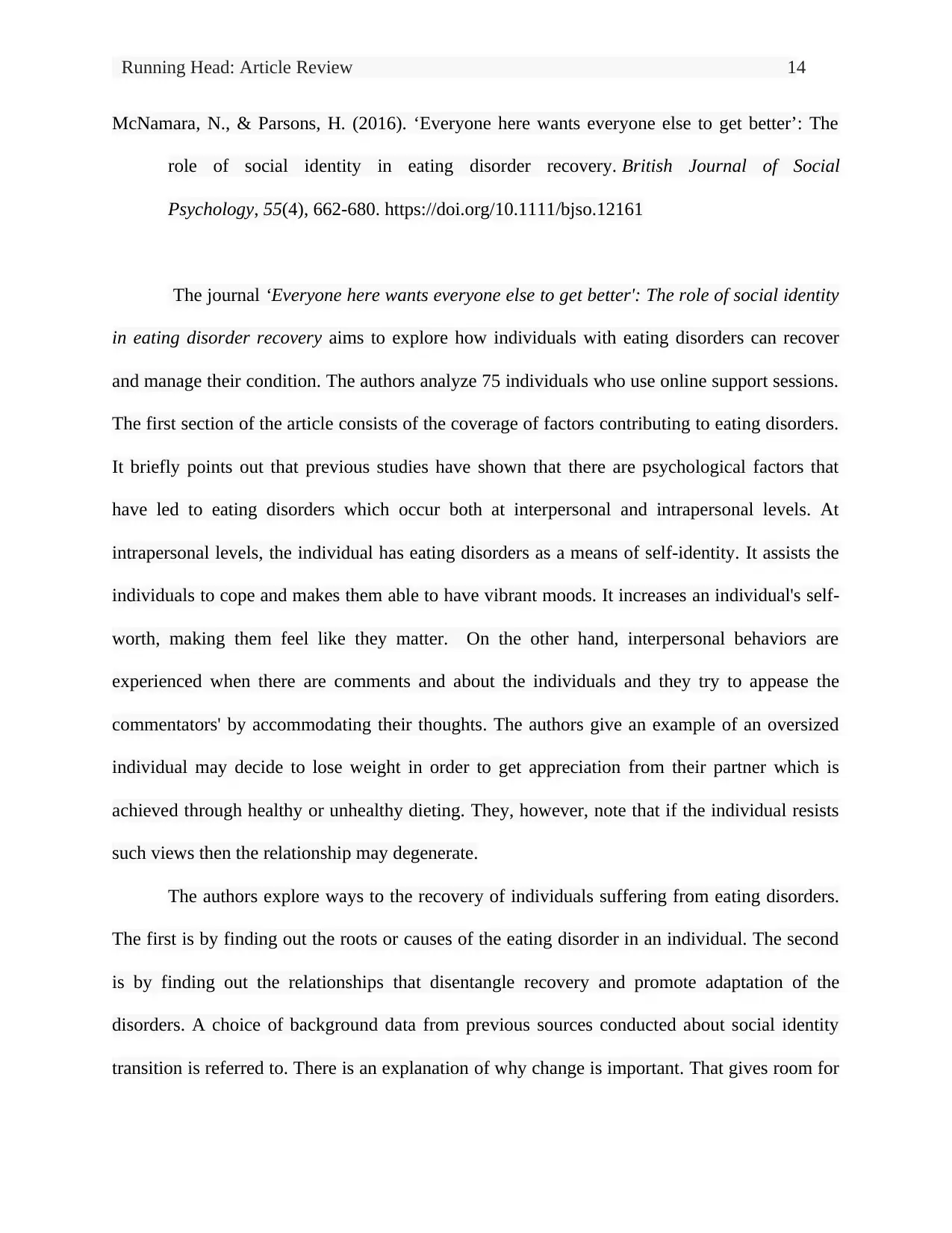
Running Head: Article Review 14
McNamara, N., & Parsons, H. (2016). ‘Everyone here wants everyone else to get better’: The
role of social identity in eating disorder recovery. British Journal of Social
Psychology, 55(4), 662-680. https://doi.org/10.1111/bjso.12161
The journal ‘Everyone here wants everyone else to get better': The role of social identity
in eating disorder recovery aims to explore how individuals with eating disorders can recover
and manage their condition. The authors analyze 75 individuals who use online support sessions.
The first section of the article consists of the coverage of factors contributing to eating disorders.
It briefly points out that previous studies have shown that there are psychological factors that
have led to eating disorders which occur both at interpersonal and intrapersonal levels. At
intrapersonal levels, the individual has eating disorders as a means of self-identity. It assists the
individuals to cope and makes them able to have vibrant moods. It increases an individual's self-
worth, making them feel like they matter. On the other hand, interpersonal behaviors are
experienced when there are comments and about the individuals and they try to appease the
commentators' by accommodating their thoughts. The authors give an example of an oversized
individual may decide to lose weight in order to get appreciation from their partner which is
achieved through healthy or unhealthy dieting. They, however, note that if the individual resists
such views then the relationship may degenerate.
The authors explore ways to the recovery of individuals suffering from eating disorders.
The first is by finding out the roots or causes of the eating disorder in an individual. The second
is by finding out the relationships that disentangle recovery and promote adaptation of the
disorders. A choice of background data from previous sources conducted about social identity
transition is referred to. There is an explanation of why change is important. That gives room for
McNamara, N., & Parsons, H. (2016). ‘Everyone here wants everyone else to get better’: The
role of social identity in eating disorder recovery. British Journal of Social
Psychology, 55(4), 662-680. https://doi.org/10.1111/bjso.12161
The journal ‘Everyone here wants everyone else to get better': The role of social identity
in eating disorder recovery aims to explore how individuals with eating disorders can recover
and manage their condition. The authors analyze 75 individuals who use online support sessions.
The first section of the article consists of the coverage of factors contributing to eating disorders.
It briefly points out that previous studies have shown that there are psychological factors that
have led to eating disorders which occur both at interpersonal and intrapersonal levels. At
intrapersonal levels, the individual has eating disorders as a means of self-identity. It assists the
individuals to cope and makes them able to have vibrant moods. It increases an individual's self-
worth, making them feel like they matter. On the other hand, interpersonal behaviors are
experienced when there are comments and about the individuals and they try to appease the
commentators' by accommodating their thoughts. The authors give an example of an oversized
individual may decide to lose weight in order to get appreciation from their partner which is
achieved through healthy or unhealthy dieting. They, however, note that if the individual resists
such views then the relationship may degenerate.
The authors explore ways to the recovery of individuals suffering from eating disorders.
The first is by finding out the roots or causes of the eating disorder in an individual. The second
is by finding out the relationships that disentangle recovery and promote adaptation of the
disorders. A choice of background data from previous sources conducted about social identity
transition is referred to. There is an explanation of why change is important. That gives room for
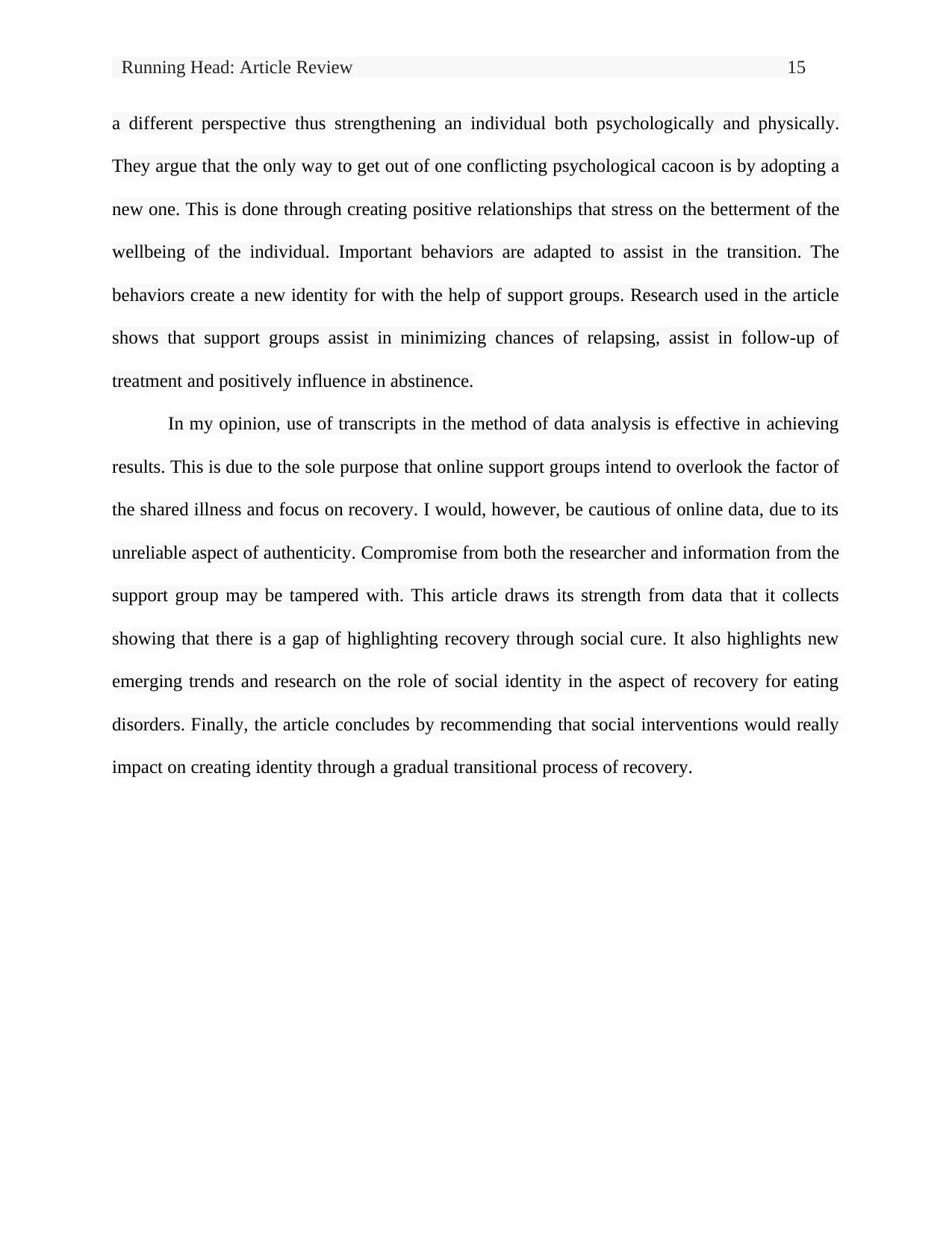
Running Head: Article Review 15
a different perspective thus strengthening an individual both psychologically and physically.
They argue that the only way to get out of one conflicting psychological cacoon is by adopting a
new one. This is done through creating positive relationships that stress on the betterment of the
wellbeing of the individual. Important behaviors are adapted to assist in the transition. The
behaviors create a new identity for with the help of support groups. Research used in the article
shows that support groups assist in minimizing chances of relapsing, assist in follow-up of
treatment and positively influence in abstinence.
In my opinion, use of transcripts in the method of data analysis is effective in achieving
results. This is due to the sole purpose that online support groups intend to overlook the factor of
the shared illness and focus on recovery. I would, however, be cautious of online data, due to its
unreliable aspect of authenticity. Compromise from both the researcher and information from the
support group may be tampered with. This article draws its strength from data that it collects
showing that there is a gap of highlighting recovery through social cure. It also highlights new
emerging trends and research on the role of social identity in the aspect of recovery for eating
disorders. Finally, the article concludes by recommending that social interventions would really
impact on creating identity through a gradual transitional process of recovery.
a different perspective thus strengthening an individual both psychologically and physically.
They argue that the only way to get out of one conflicting psychological cacoon is by adopting a
new one. This is done through creating positive relationships that stress on the betterment of the
wellbeing of the individual. Important behaviors are adapted to assist in the transition. The
behaviors create a new identity for with the help of support groups. Research used in the article
shows that support groups assist in minimizing chances of relapsing, assist in follow-up of
treatment and positively influence in abstinence.
In my opinion, use of transcripts in the method of data analysis is effective in achieving
results. This is due to the sole purpose that online support groups intend to overlook the factor of
the shared illness and focus on recovery. I would, however, be cautious of online data, due to its
unreliable aspect of authenticity. Compromise from both the researcher and information from the
support group may be tampered with. This article draws its strength from data that it collects
showing that there is a gap of highlighting recovery through social cure. It also highlights new
emerging trends and research on the role of social identity in the aspect of recovery for eating
disorders. Finally, the article concludes by recommending that social interventions would really
impact on creating identity through a gradual transitional process of recovery.
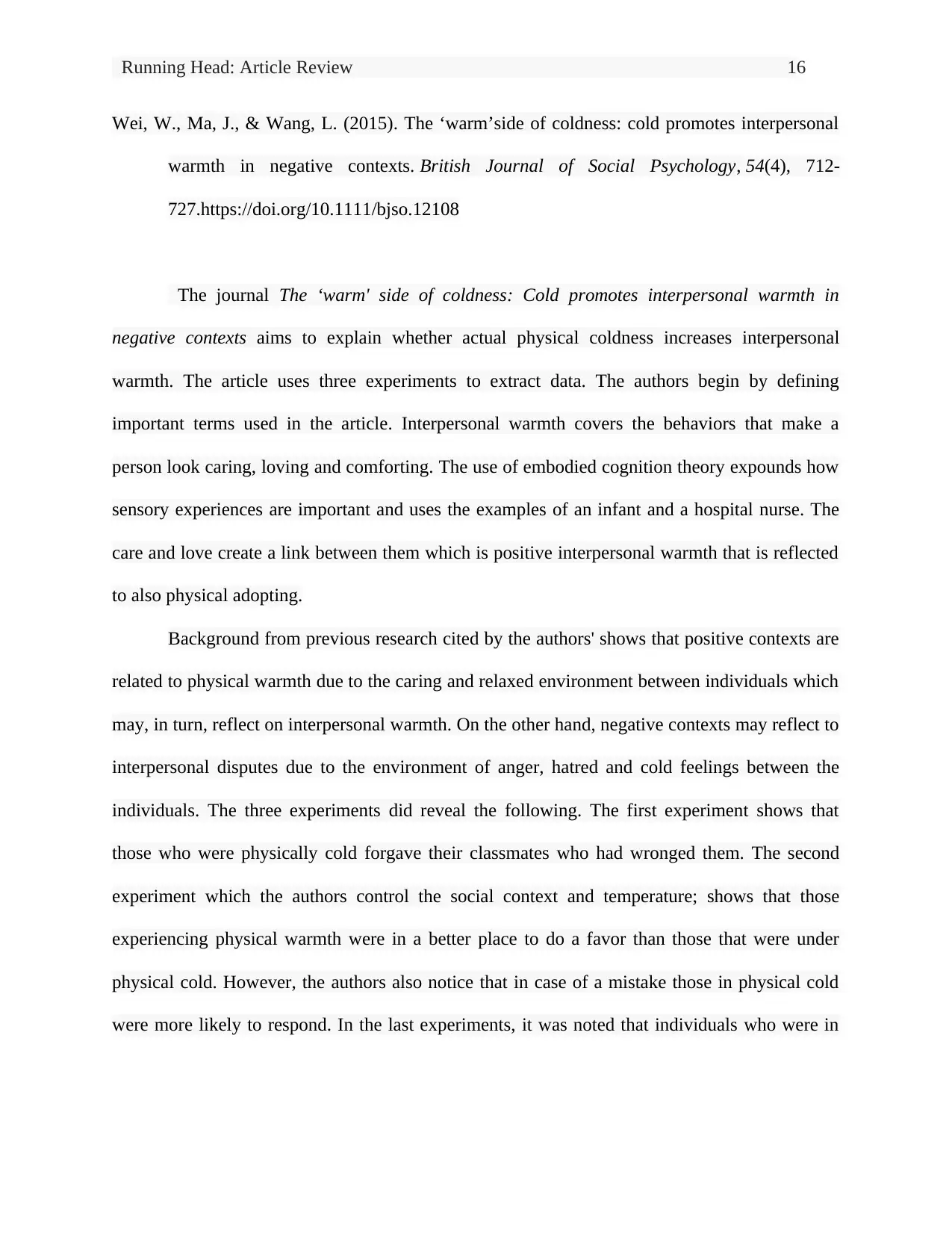
Running Head: Article Review 16
Wei, W., Ma, J., & Wang, L. (2015). The ‘warm’side of coldness: cold promotes interpersonal
warmth in negative contexts. British Journal of Social Psychology, 54(4), 712-
727.https://doi.org/10.1111/bjso.12108
The journal The ‘warm' side of coldness: Cold promotes interpersonal warmth in
negative contexts aims to explain whether actual physical coldness increases interpersonal
warmth. The article uses three experiments to extract data. The authors begin by defining
important terms used in the article. Interpersonal warmth covers the behaviors that make a
person look caring, loving and comforting. The use of embodied cognition theory expounds how
sensory experiences are important and uses the examples of an infant and a hospital nurse. The
care and love create a link between them which is positive interpersonal warmth that is reflected
to also physical adopting.
Background from previous research cited by the authors' shows that positive contexts are
related to physical warmth due to the caring and relaxed environment between individuals which
may, in turn, reflect on interpersonal warmth. On the other hand, negative contexts may reflect to
interpersonal disputes due to the environment of anger, hatred and cold feelings between the
individuals. The three experiments did reveal the following. The first experiment shows that
those who were physically cold forgave their classmates who had wronged them. The second
experiment which the authors control the social context and temperature; shows that those
experiencing physical warmth were in a better place to do a favor than those that were under
physical cold. However, the authors also notice that in case of a mistake those in physical cold
were more likely to respond. In the last experiments, it was noted that individuals who were in
Wei, W., Ma, J., & Wang, L. (2015). The ‘warm’side of coldness: cold promotes interpersonal
warmth in negative contexts. British Journal of Social Psychology, 54(4), 712-
727.https://doi.org/10.1111/bjso.12108
The journal The ‘warm' side of coldness: Cold promotes interpersonal warmth in
negative contexts aims to explain whether actual physical coldness increases interpersonal
warmth. The article uses three experiments to extract data. The authors begin by defining
important terms used in the article. Interpersonal warmth covers the behaviors that make a
person look caring, loving and comforting. The use of embodied cognition theory expounds how
sensory experiences are important and uses the examples of an infant and a hospital nurse. The
care and love create a link between them which is positive interpersonal warmth that is reflected
to also physical adopting.
Background from previous research cited by the authors' shows that positive contexts are
related to physical warmth due to the caring and relaxed environment between individuals which
may, in turn, reflect on interpersonal warmth. On the other hand, negative contexts may reflect to
interpersonal disputes due to the environment of anger, hatred and cold feelings between the
individuals. The three experiments did reveal the following. The first experiment shows that
those who were physically cold forgave their classmates who had wronged them. The second
experiment which the authors control the social context and temperature; shows that those
experiencing physical warmth were in a better place to do a favor than those that were under
physical cold. However, the authors also notice that in case of a mistake those in physical cold
were more likely to respond. In the last experiments, it was noted that individuals who were in
Secure Best Marks with AI Grader
Need help grading? Try our AI Grader for instant feedback on your assignments.
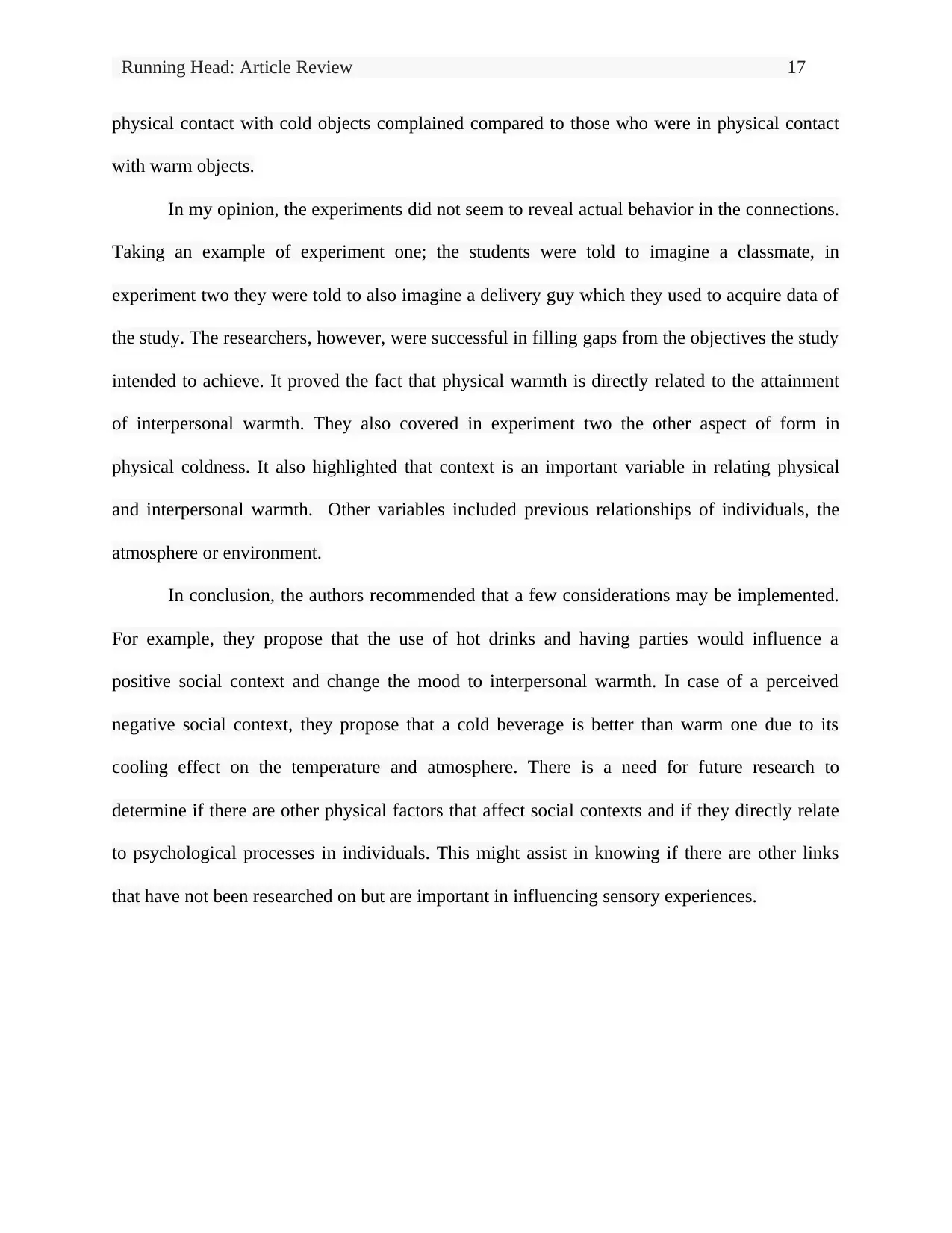
Running Head: Article Review 17
physical contact with cold objects complained compared to those who were in physical contact
with warm objects.
In my opinion, the experiments did not seem to reveal actual behavior in the connections.
Taking an example of experiment one; the students were told to imagine a classmate, in
experiment two they were told to also imagine a delivery guy which they used to acquire data of
the study. The researchers, however, were successful in filling gaps from the objectives the study
intended to achieve. It proved the fact that physical warmth is directly related to the attainment
of interpersonal warmth. They also covered in experiment two the other aspect of form in
physical coldness. It also highlighted that context is an important variable in relating physical
and interpersonal warmth. Other variables included previous relationships of individuals, the
atmosphere or environment.
In conclusion, the authors recommended that a few considerations may be implemented.
For example, they propose that the use of hot drinks and having parties would influence a
positive social context and change the mood to interpersonal warmth. In case of a perceived
negative social context, they propose that a cold beverage is better than warm one due to its
cooling effect on the temperature and atmosphere. There is a need for future research to
determine if there are other physical factors that affect social contexts and if they directly relate
to psychological processes in individuals. This might assist in knowing if there are other links
that have not been researched on but are important in influencing sensory experiences.
physical contact with cold objects complained compared to those who were in physical contact
with warm objects.
In my opinion, the experiments did not seem to reveal actual behavior in the connections.
Taking an example of experiment one; the students were told to imagine a classmate, in
experiment two they were told to also imagine a delivery guy which they used to acquire data of
the study. The researchers, however, were successful in filling gaps from the objectives the study
intended to achieve. It proved the fact that physical warmth is directly related to the attainment
of interpersonal warmth. They also covered in experiment two the other aspect of form in
physical coldness. It also highlighted that context is an important variable in relating physical
and interpersonal warmth. Other variables included previous relationships of individuals, the
atmosphere or environment.
In conclusion, the authors recommended that a few considerations may be implemented.
For example, they propose that the use of hot drinks and having parties would influence a
positive social context and change the mood to interpersonal warmth. In case of a perceived
negative social context, they propose that a cold beverage is better than warm one due to its
cooling effect on the temperature and atmosphere. There is a need for future research to
determine if there are other physical factors that affect social contexts and if they directly relate
to psychological processes in individuals. This might assist in knowing if there are other links
that have not been researched on but are important in influencing sensory experiences.
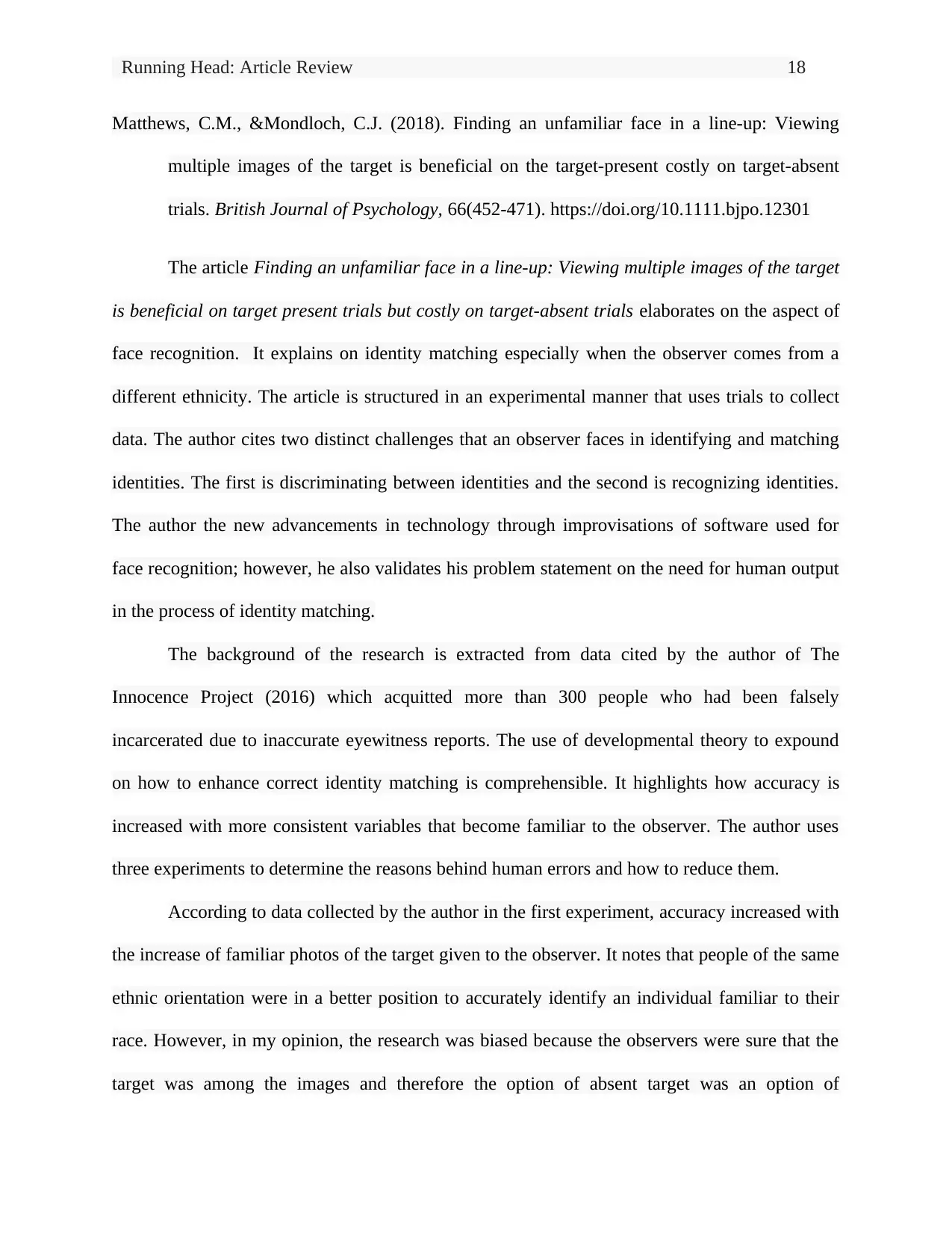
Running Head: Article Review 18
Matthews, C.M., &Mondloch, C.J. (2018). Finding an unfamiliar face in a line-up: Viewing
multiple images of the target is beneficial on the target-present costly on target-absent
trials. British Journal of Psychology, 66(452-471). https://doi.org/10.1111.bjpo.12301
The article Finding an unfamiliar face in a line-up: Viewing multiple images of the target
is beneficial on target present trials but costly on target-absent trials elaborates on the aspect of
face recognition. It explains on identity matching especially when the observer comes from a
different ethnicity. The article is structured in an experimental manner that uses trials to collect
data. The author cites two distinct challenges that an observer faces in identifying and matching
identities. The first is discriminating between identities and the second is recognizing identities.
The author the new advancements in technology through improvisations of software used for
face recognition; however, he also validates his problem statement on the need for human output
in the process of identity matching.
The background of the research is extracted from data cited by the author of The
Innocence Project (2016) which acquitted more than 300 people who had been falsely
incarcerated due to inaccurate eyewitness reports. The use of developmental theory to expound
on how to enhance correct identity matching is comprehensible. It highlights how accuracy is
increased with more consistent variables that become familiar to the observer. The author uses
three experiments to determine the reasons behind human errors and how to reduce them.
According to data collected by the author in the first experiment, accuracy increased with
the increase of familiar photos of the target given to the observer. It notes that people of the same
ethnic orientation were in a better position to accurately identify an individual familiar to their
race. However, in my opinion, the research was biased because the observers were sure that the
target was among the images and therefore the option of absent target was an option of
Matthews, C.M., &Mondloch, C.J. (2018). Finding an unfamiliar face in a line-up: Viewing
multiple images of the target is beneficial on the target-present costly on target-absent
trials. British Journal of Psychology, 66(452-471). https://doi.org/10.1111.bjpo.12301
The article Finding an unfamiliar face in a line-up: Viewing multiple images of the target
is beneficial on target present trials but costly on target-absent trials elaborates on the aspect of
face recognition. It explains on identity matching especially when the observer comes from a
different ethnicity. The article is structured in an experimental manner that uses trials to collect
data. The author cites two distinct challenges that an observer faces in identifying and matching
identities. The first is discriminating between identities and the second is recognizing identities.
The author the new advancements in technology through improvisations of software used for
face recognition; however, he also validates his problem statement on the need for human output
in the process of identity matching.
The background of the research is extracted from data cited by the author of The
Innocence Project (2016) which acquitted more than 300 people who had been falsely
incarcerated due to inaccurate eyewitness reports. The use of developmental theory to expound
on how to enhance correct identity matching is comprehensible. It highlights how accuracy is
increased with more consistent variables that become familiar to the observer. The author uses
three experiments to determine the reasons behind human errors and how to reduce them.
According to data collected by the author in the first experiment, accuracy increased with
the increase of familiar photos of the target given to the observer. It notes that people of the same
ethnic orientation were in a better position to accurately identify an individual familiar to their
race. However, in my opinion, the research was biased because the observers were sure that the
target was among the images and therefore the option of absent target was an option of
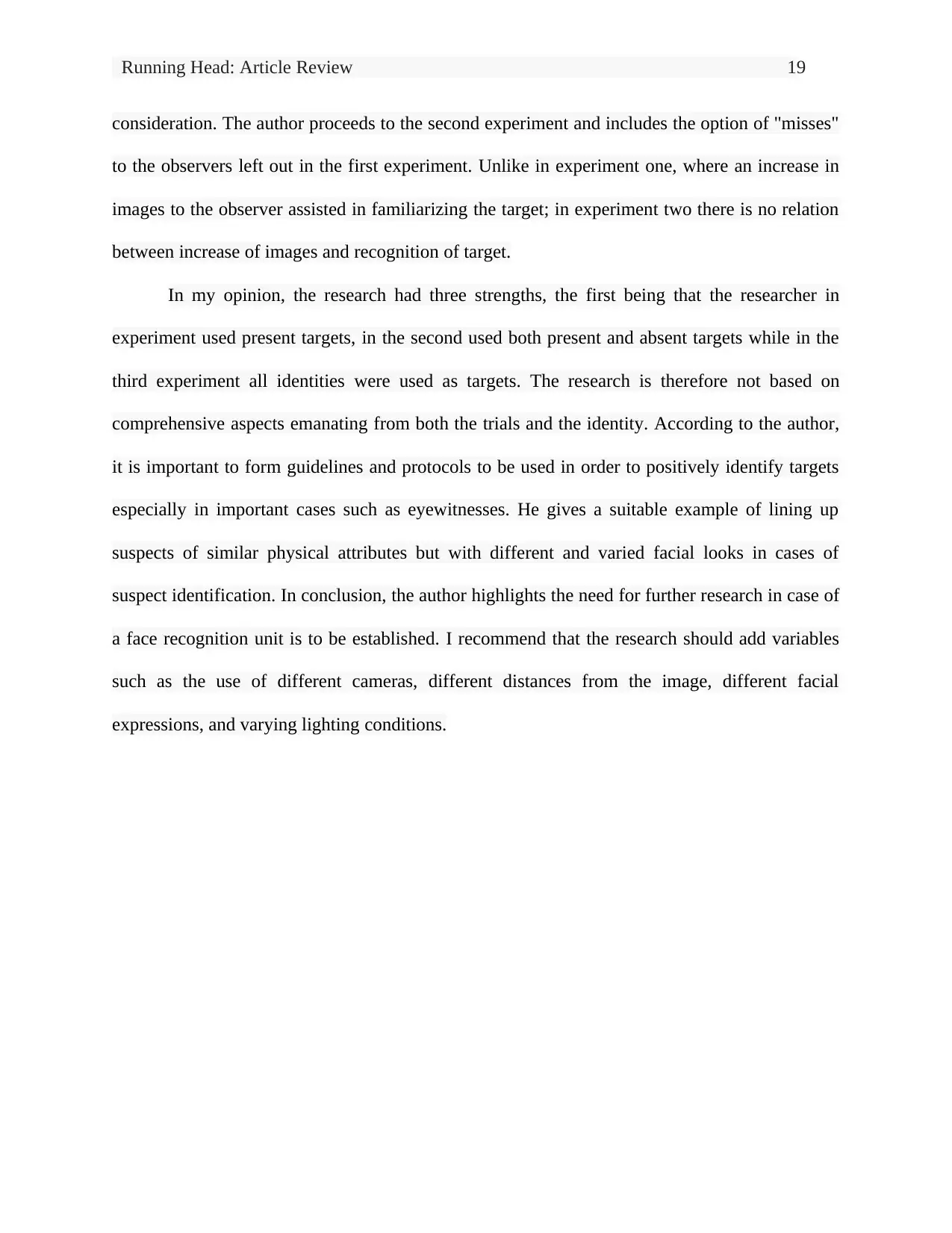
Running Head: Article Review 19
consideration. The author proceeds to the second experiment and includes the option of "misses"
to the observers left out in the first experiment. Unlike in experiment one, where an increase in
images to the observer assisted in familiarizing the target; in experiment two there is no relation
between increase of images and recognition of target.
In my opinion, the research had three strengths, the first being that the researcher in
experiment used present targets, in the second used both present and absent targets while in the
third experiment all identities were used as targets. The research is therefore not based on
comprehensive aspects emanating from both the trials and the identity. According to the author,
it is important to form guidelines and protocols to be used in order to positively identify targets
especially in important cases such as eyewitnesses. He gives a suitable example of lining up
suspects of similar physical attributes but with different and varied facial looks in cases of
suspect identification. In conclusion, the author highlights the need for further research in case of
a face recognition unit is to be established. I recommend that the research should add variables
such as the use of different cameras, different distances from the image, different facial
expressions, and varying lighting conditions.
consideration. The author proceeds to the second experiment and includes the option of "misses"
to the observers left out in the first experiment. Unlike in experiment one, where an increase in
images to the observer assisted in familiarizing the target; in experiment two there is no relation
between increase of images and recognition of target.
In my opinion, the research had three strengths, the first being that the researcher in
experiment used present targets, in the second used both present and absent targets while in the
third experiment all identities were used as targets. The research is therefore not based on
comprehensive aspects emanating from both the trials and the identity. According to the author,
it is important to form guidelines and protocols to be used in order to positively identify targets
especially in important cases such as eyewitnesses. He gives a suitable example of lining up
suspects of similar physical attributes but with different and varied facial looks in cases of
suspect identification. In conclusion, the author highlights the need for further research in case of
a face recognition unit is to be established. I recommend that the research should add variables
such as the use of different cameras, different distances from the image, different facial
expressions, and varying lighting conditions.
Paraphrase This Document
Need a fresh take? Get an instant paraphrase of this document with our AI Paraphraser
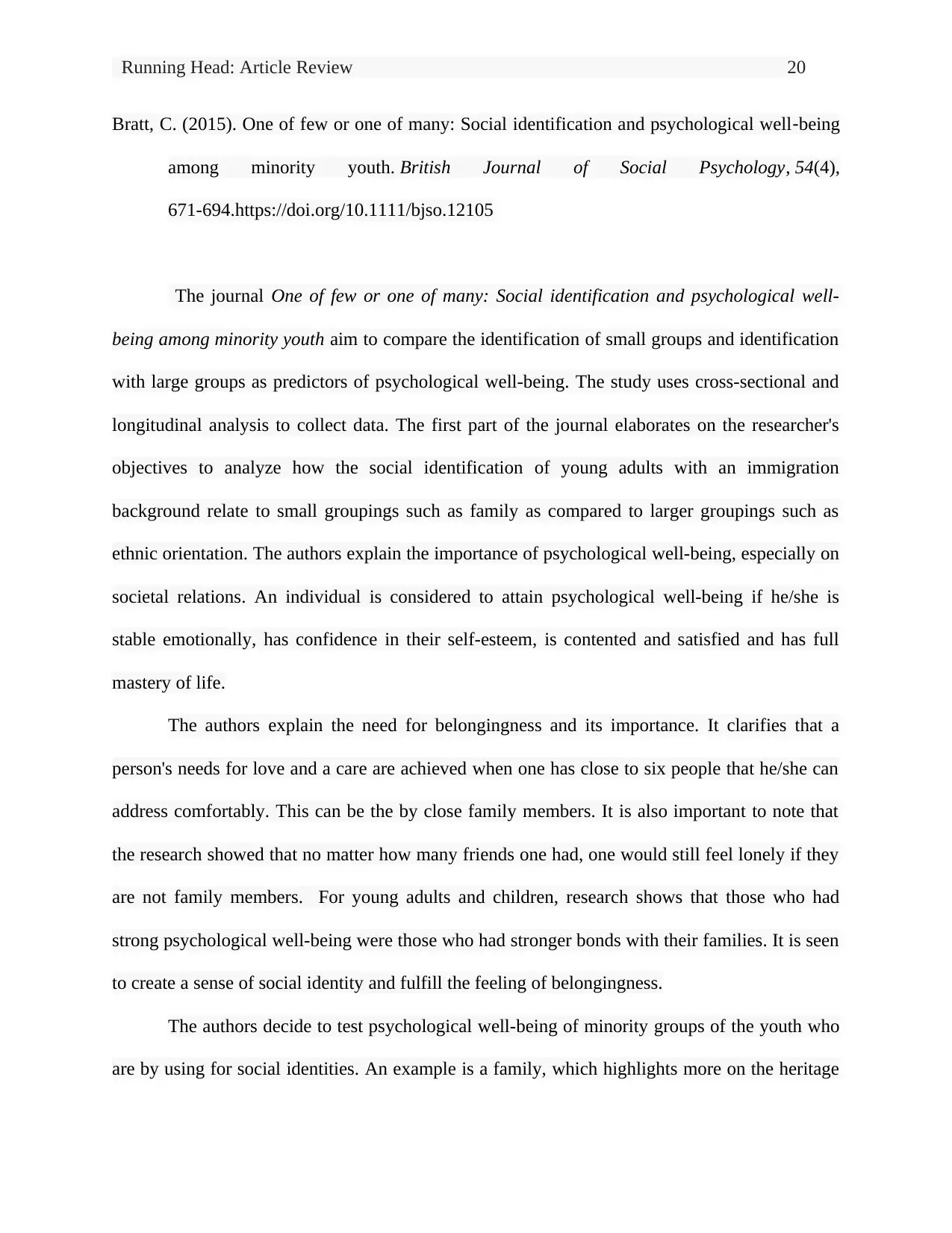
Running Head: Article Review 20
Bratt, C. (2015). One of few or one of many: Social identification and psychological well‐being
among minority youth. British Journal of Social Psychology, 54(4),
671-694.https://doi.org/10.1111/bjso.12105
The journal One of few or one of many: Social identification and psychological well-
being among minority youth aim to compare the identification of small groups and identification
with large groups as predictors of psychological well-being. The study uses cross-sectional and
longitudinal analysis to collect data. The first part of the journal elaborates on the researcher's
objectives to analyze how the social identification of young adults with an immigration
background relate to small groupings such as family as compared to larger groupings such as
ethnic orientation. The authors explain the importance of psychological well-being, especially on
societal relations. An individual is considered to attain psychological well-being if he/she is
stable emotionally, has confidence in their self-esteem, is contented and satisfied and has full
mastery of life.
The authors explain the need for belongingness and its importance. It clarifies that a
person's needs for love and a care are achieved when one has close to six people that he/she can
address comfortably. This can be the by close family members. It is also important to note that
the research showed that no matter how many friends one had, one would still feel lonely if they
are not family members. For young adults and children, research shows that those who had
strong psychological well-being were those who had stronger bonds with their families. It is seen
to create a sense of social identity and fulfill the feeling of belongingness.
The authors decide to test psychological well-being of minority groups of the youth who
are by using for social identities. An example is a family, which highlights more on the heritage
Bratt, C. (2015). One of few or one of many: Social identification and psychological well‐being
among minority youth. British Journal of Social Psychology, 54(4),
671-694.https://doi.org/10.1111/bjso.12105
The journal One of few or one of many: Social identification and psychological well-
being among minority youth aim to compare the identification of small groups and identification
with large groups as predictors of psychological well-being. The study uses cross-sectional and
longitudinal analysis to collect data. The first part of the journal elaborates on the researcher's
objectives to analyze how the social identification of young adults with an immigration
background relate to small groupings such as family as compared to larger groupings such as
ethnic orientation. The authors explain the importance of psychological well-being, especially on
societal relations. An individual is considered to attain psychological well-being if he/she is
stable emotionally, has confidence in their self-esteem, is contented and satisfied and has full
mastery of life.
The authors explain the need for belongingness and its importance. It clarifies that a
person's needs for love and a care are achieved when one has close to six people that he/she can
address comfortably. This can be the by close family members. It is also important to note that
the research showed that no matter how many friends one had, one would still feel lonely if they
are not family members. For young adults and children, research shows that those who had
strong psychological well-being were those who had stronger bonds with their families. It is seen
to create a sense of social identity and fulfill the feeling of belongingness.
The authors decide to test psychological well-being of minority groups of the youth who
are by using for social identities. An example is a family, which highlights more on the heritage
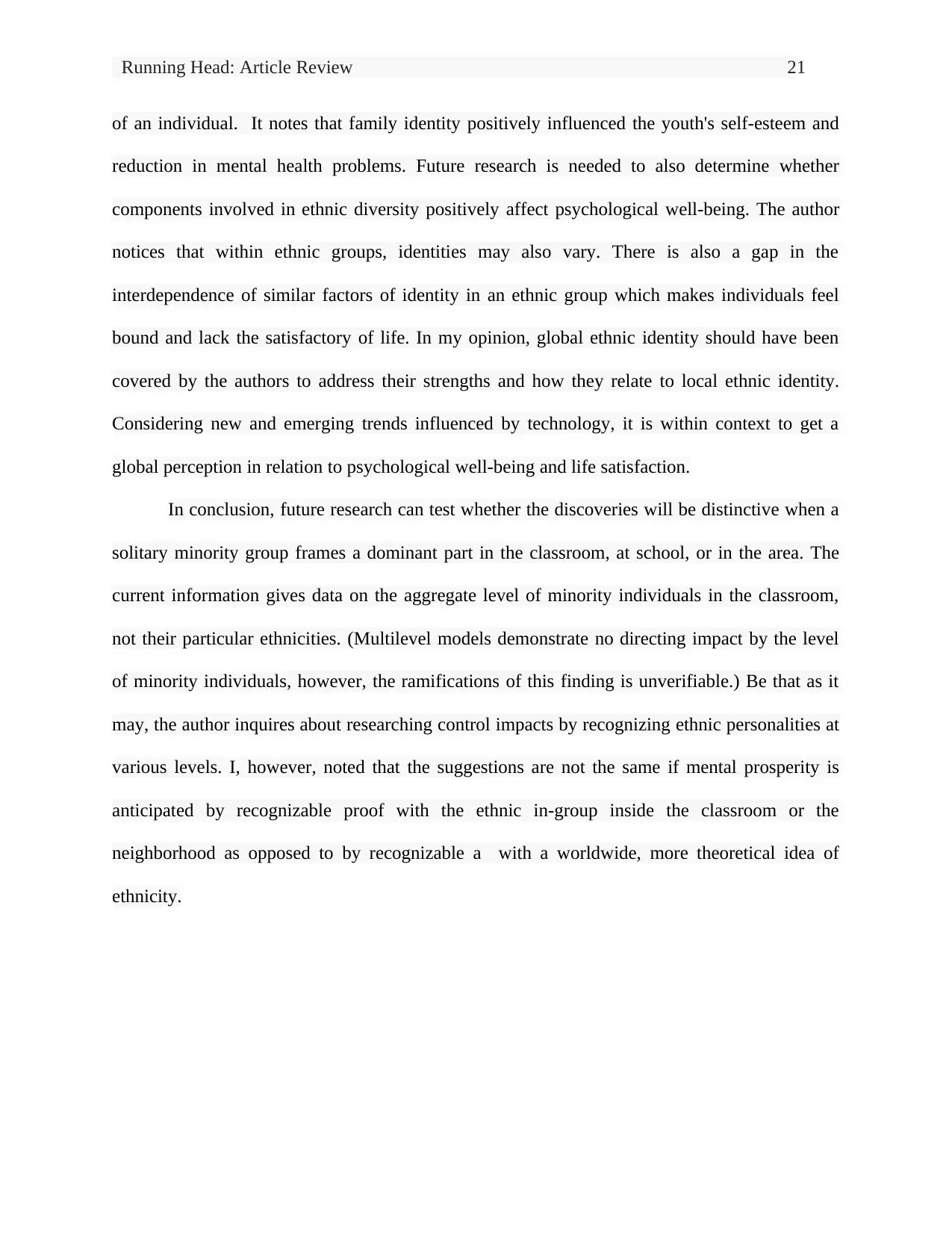
Running Head: Article Review 21
of an individual. It notes that family identity positively influenced the youth's self-esteem and
reduction in mental health problems. Future research is needed to also determine whether
components involved in ethnic diversity positively affect psychological well-being. The author
notices that within ethnic groups, identities may also vary. There is also a gap in the
interdependence of similar factors of identity in an ethnic group which makes individuals feel
bound and lack the satisfactory of life. In my opinion, global ethnic identity should have been
covered by the authors to address their strengths and how they relate to local ethnic identity.
Considering new and emerging trends influenced by technology, it is within context to get a
global perception in relation to psychological well-being and life satisfaction.
In conclusion, future research can test whether the discoveries will be distinctive when a
solitary minority group frames a dominant part in the classroom, at school, or in the area. The
current information gives data on the aggregate level of minority individuals in the classroom,
not their particular ethnicities. (Multilevel models demonstrate no directing impact by the level
of minority individuals, however, the ramifications of this finding is unverifiable.) Be that as it
may, the author inquires about researching control impacts by recognizing ethnic personalities at
various levels. I, however, noted that the suggestions are not the same if mental prosperity is
anticipated by recognizable proof with the ethnic in-group inside the classroom or the
neighborhood as opposed to by recognizable a with a worldwide, more theoretical idea of
ethnicity.
of an individual. It notes that family identity positively influenced the youth's self-esteem and
reduction in mental health problems. Future research is needed to also determine whether
components involved in ethnic diversity positively affect psychological well-being. The author
notices that within ethnic groups, identities may also vary. There is also a gap in the
interdependence of similar factors of identity in an ethnic group which makes individuals feel
bound and lack the satisfactory of life. In my opinion, global ethnic identity should have been
covered by the authors to address their strengths and how they relate to local ethnic identity.
Considering new and emerging trends influenced by technology, it is within context to get a
global perception in relation to psychological well-being and life satisfaction.
In conclusion, future research can test whether the discoveries will be distinctive when a
solitary minority group frames a dominant part in the classroom, at school, or in the area. The
current information gives data on the aggregate level of minority individuals in the classroom,
not their particular ethnicities. (Multilevel models demonstrate no directing impact by the level
of minority individuals, however, the ramifications of this finding is unverifiable.) Be that as it
may, the author inquires about researching control impacts by recognizing ethnic personalities at
various levels. I, however, noted that the suggestions are not the same if mental prosperity is
anticipated by recognizable proof with the ethnic in-group inside the classroom or the
neighborhood as opposed to by recognizable a with a worldwide, more theoretical idea of
ethnicity.
1 out of 21
Related Documents
Your All-in-One AI-Powered Toolkit for Academic Success.
+13062052269
info@desklib.com
Available 24*7 on WhatsApp / Email
![[object Object]](/_next/static/media/star-bottom.7253800d.svg)
Unlock your academic potential
© 2024 | Zucol Services PVT LTD | All rights reserved.





